
I have taught things that made no claim to transgress anything, but simply to define a certain number of knots, points of impossibility. –Jacques Lacan, … ou pire
In the catalogue for Simon Hantaï’s 1999 retrospective at the Westfälisches Landesmuseum für Kunst und Kulturgeschichte in Münster, Germany, there appear reproduced, side-by-side on a single page, two paintings that also were placed adjacent to one another within the show itself (figs. 2-3).1 Both are from 1968 and belong to the series called Les Meuns, after the tiny hamlet near the Forêt de Fontainebleau where Hantaï recently had established a studio-residence. The paintings are of similar dimensions, being just slightly taller than the standing human form, and very nearly square. Comparable, too, is the overall disposition of painted forms: both reveal quatrefoil, roughly lobed shapes—one lobe in each quadrant of the painting—and both are similarly marked, in the upper right quadrants, with downward-slashing diagonals of nonpainted canvas. Clearly, the two paintings form a couple.
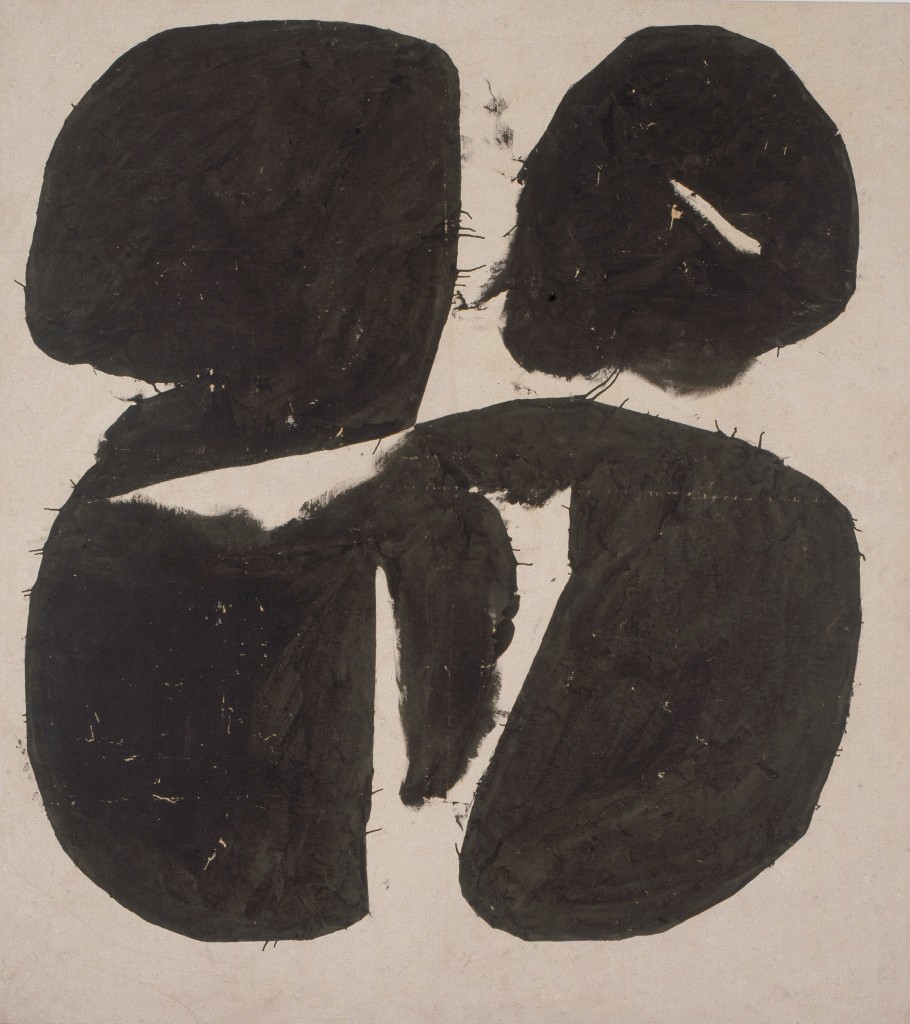
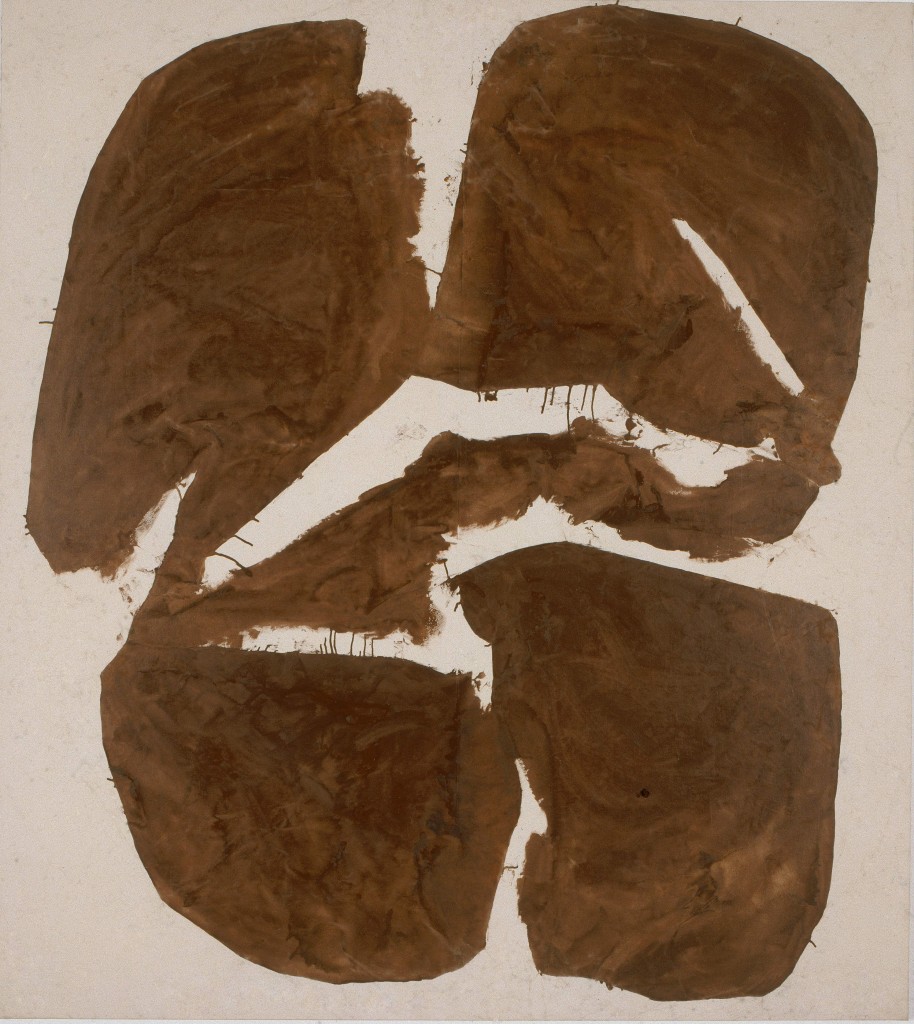
But as many couples do, the two paintings also reveal striking differences; indeed, they appear differently sexed. There is, to begin with, that oblong form between the black Meun’s two lower lobes. Not only is it missing from the brown Meun, the latter painting’s midsection is traversed instead by long, horizontal slits. Once noticed, the overall impression before both works is of an exaggerated, almost cartoonish figuring of masculine and feminine anatomies. Given Hantaï’s highly active participation both in the preparation of the Münster catalogue and in the installation of the show itself, something of the artist’s own, barely suppressed laughter seems to echo from this pointed pairing.
That laughter, might one share it, would also be a challenge. For humor is not a quality often associated with Hantaï’s art. Born in Bia, Hungary, in 1922, and active in France from 1948 until his death in 2008, Hantaï is revered as one of the most important figures in French art of the later twentieth century. A member of André Breton’s Surrealist circle in the early 1950s, he also became, in the course of that decade, one of the first artists in Paris to notice and respond to the work of Jackson Pollock and other American Abstract Expressionists. Beginning in 1960, he developed what has come to be known as his pliage “method”: essentially the painting of a crumpled, folded, or knotted canvas that is then unfolded and stretched for exhibition.
The Meuns generally are taken to mark a key crux in the pliage work—at once the onset of Hantaï’s mature reckoning with a prior French tradition in which Cézanne and Matisse figure crucially, and, by that same token, the definitive overcoming of Surrealist outrance by modernist discipline. The dominant narrative of Hantaï’s trajectory, as summed up by Musée national d’art moderne director Pontus Hulten on the occasion of the artist’s 1976 retrospective at his institution, is that of “a sublimated vision,” passing from “a sort of visionary humus” to “a new life of painting, rooted in light.”2 The later Hantaï is a painter of light, not bodies; his forms so definitively depsychologized as not to be properly intended at all. And yet…
Black humor, at least, did play a marked role in Hantaï’s earlier art and his framing of it: this is, after all, the same painter who dedicated his first solo exhibition after the break with Breton to Jean-Pierre Brisset, a nineteenth-century grammarian best known for claiming that the discovery of sex was the “first excess,” indelibly recorded in vertiginous and often stupefying puns lurking just beneath the surface of ordinary language.3 And as the two Meuns in the Münster catalogue appear determined to remind us, references to sexuality, and feminine sexuality in particular, recur in the later pliage work, as they recurred in Hantaï’s own comments about his art. Later in life, Hantaï often forced the issue, claiming to spend his days in the studio “spreading vaginas”—a reference to the folds of his unstretched canvases—and describing his glorious first pliage series, the Mariales, as keyed to what’s “under” the Virgin’s skirt.4 Many of these comments doubtless were meant to provoke and discomfit, and run their own risks of banalizing what was, from first to last, an extraordinarily complex and searching practice. But they also were consistent with Hantaï’s larger commitment to “impurity”—a commitment that was, itself, at once ethical and polemical, deeply held and willfully deflationary.5 That commitment remains largely unaccounted for in the existing narratives of Hantaï’s art.
This essay advances a new story—one aimed at rethinking the relation of Hantaï’s later pliage work to the earlier Surrealist excesses, and at the recovery of deep continuities among the more evident ruptures. Of special interest to this account is the role of “the feminine” (or better, “femellité”) in Hantaï’s work and thought from the 1950s forward. Hantaï is a key figure for modernity precisely because he brings together two major problematics we tend to think of as distinct—the Surrealist exploration of sexuality and the modernist investigation of medium—and makes them mutually driving for his art. In so doing, he also provides a powerful response to then-emerging narratives of modernism as a drive toward “flatness” or “the literal,” pointing toward a more difficult and nuanced vision of painting as a medium.
I
Some time in the course of 1953, while Hantaï was an active member of Breton’s group, he painted two canvases called Peinture (Femelle-Miroir I) and Peinture (Femelle-Miroir II) (figs. 4-5).6 Despite their sequential titles, the paintings probably were worked on more or less simultaneously in the studio, and the “I” and “II” might be taken as reflecting something more like conceptual or mythical than literal succession. Each painting turns upon a central figure—presumably, the title’s Femelle—painted, for the most part, in sickly, acid green tints; and each portrays that figure before a real or suggested mirror. Both are fairly large for Hantaï at that time, with Femelle-Miroir I standing slightly taller, and both were produced through controlled acts of raclage, a technique that involved applying paint to the canvas and then removing it selectively with razor blades and other implements. They are also, to put it mildly, among the unloveliest pictures Hantaï ever made, and even the painter’s most ardent admirers rarely dwell on this period of his production. Nonetheless, they can help to illuminate both what Hantaï took from the Surrealist leader’s discourse on desire, and what in it he resisted.7
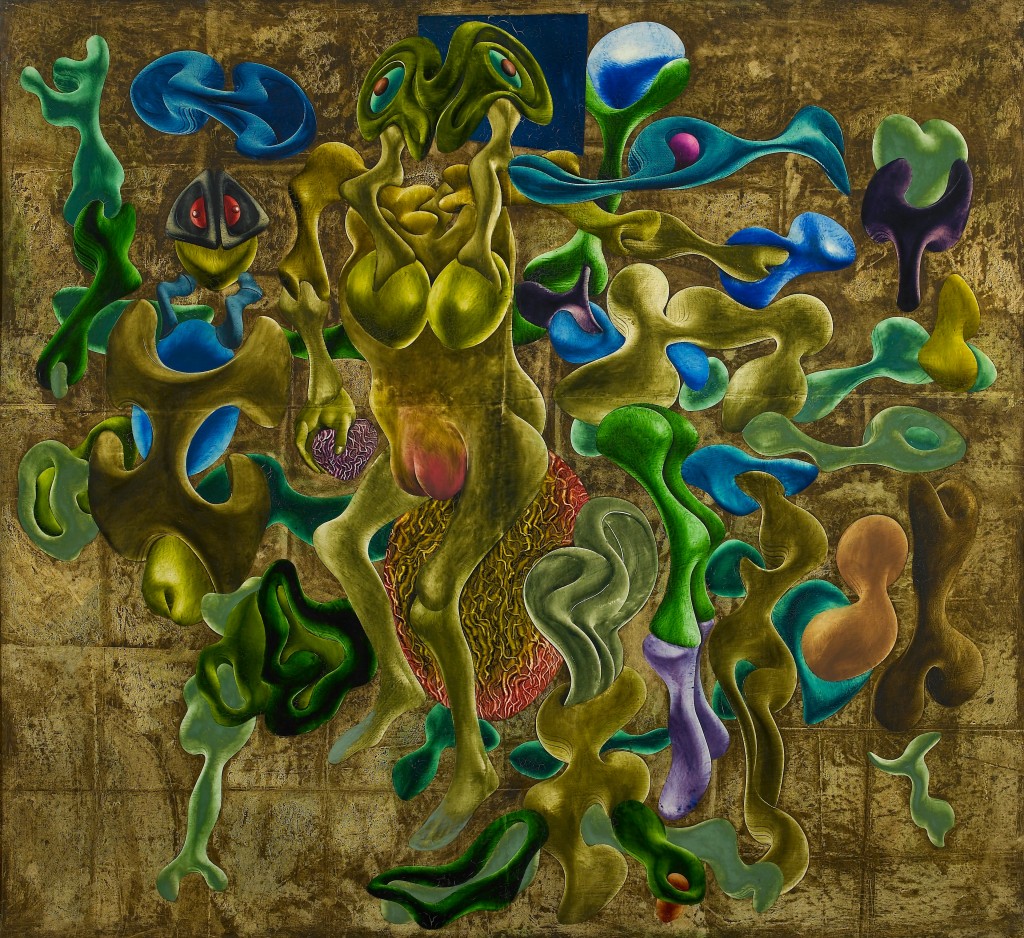
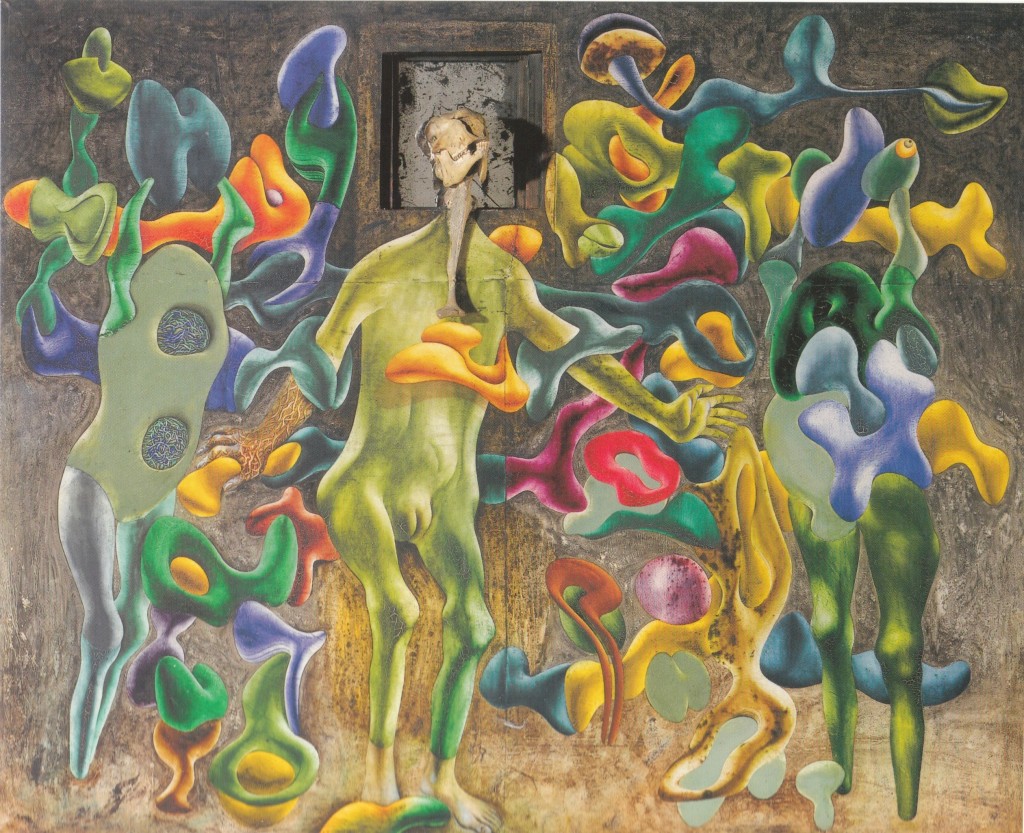
Clear debts are flagged from the first by the paintings’ title’s notion of a “Femelle-Miroir,” a conjunction borrowed from one of Breton’s best known poems.8 Entitled “Free Union,” it appeared first in the 1931 collection Earthlight, and later was included among Maurice Nadeau’s selection of representative Surrealist documents in his foundational history, the 1944 The History of Surrealism. A central statement in the annals of Surrealist poetry, it is among the most striking manifestations of Breton’s persistent tendency to associate that practice with an exalted femininity, the latter serving as the catalyst and support for the former.
Breton’s poem offers a series of striking images of a woman, identified only—and repeatedly—as “ma femme,” and typically translated into English as “my wife.” Each line focuses on a specific physical attribute, from the opening “My wife with her wood-fire hair” to “My wife with breasts of a deepsea molehill” and “My wife with springtime buttocks,” among other images.9 In so doing, each line also offers a double context in which to consider the poem’s title. On the one hand, Breton’s amorous inventory of the feminine anatomy is consistent with the larger Surrealist celebration of romantic love and sexual freedom. On the other, each image is itself an example of “free union”—the “fortuitous juxtaposition” of “two distant realities” invoked from the 1924 “Manifesto” forward as the defining principle of Surrealist poetics.10 Those images, Breton never ceased to stress, are less forged by the Surrealist poet than received by him as luminous revelations of his own desire: “The mind becomes aware of the limitless expanses wherein its desires are made manifest […] where its obscurity does not betray it” (“Manifesto,” 37).
These two kinds of “union” are superimposed ceaselessly throughout the poem, as when Breton presents his femme as endowed with “fingers of chance” or—the line on which Hantaï draws—a “mirror sex” (“Free Union,” 283-84). She, like the notionally automatic images that are all we know of her, offers a heightened reflection to the poet, one that both completes him and reveals him to himself. Accordingly, despite the seeming dispersion of her body into a succession of disparate images, Breton’s femme nonetheless appears in the poem’s final line as the site of a higher unity: in her “eyes of water level air level earth and fire level,” she rises to the height of the four classical elements—all the material of which the world is made, and to be made anew (“Free Union,” 284).
Hantaï’s response to Breton’s poem shows him working at once with and against the grain of the elder man’s practice and theory, in at least two key and closely related respects. First, he refuses Breton’s idealist elevation of his feminine muse, recasting his title protagonist as the femelle of a decidedly nonhuman, indeed monstrous, species. Second, he displaces Breton’s hallucinatory emphasis on the notionally separable metaphoric incident—each line of verse, like each body part, a distinct jewel in its own right—in favor of the formal and metonymic rhythms and permutations of a comparatively circumscribed range of biomorphic shapes. For where Breton’s femme appears the unifying support for a seemingly inexhaustible production of poetic images, Hantaï’s femelle is a literal composite, an aggregate of interlocking but seemingly detachable or movable parts—and indeed, it is precisely this that appears monstrous.11
The zeppelin-like “breasts,” for example, not only are mismatched shapes, but also appear utterly distinct from the torso as a whole. But for a curiously human right hand, the figure’s arms appear constructed of repeating wrench-shapes. The mandibles connecting head to breasts rhyme uncannily with the figure’s legs. The odd double knee of the figure’s proper left leg appears a reversed and slightly smaller version of the no less oddly rotated and stacked buttocks. And so on. Further compounding these repeating formal echoes and rhymes, virtually all the forms that compose this body have counterparts or near-counterparts in the more dispersed forms that take up the rest of the field.
It is as if Femelle-Miroir I shows those forms coming together momentarily to make a figure; or, alternately, that we are to imagine those forms as the dispersed remnants or disjecta of a broken-down figure, regrouping beyond the limits of the person. (That we read the “figure” on the left as having lost a leg seems to support the latter view.) Either way, the femelle’s realm appears as one that somehow refuses or resists totalization—its emblematic figure having, as it were, no solid center of its own. That lack finds mythical expression in Hantaï’s displaced and almost comically hideous version of a “mirror sex”: the striking double image of gaping maw and opaque, depicted mirror, the darkness of which reads initially as a hole in the support itself.
Hantaï’s “displacements” of Breton draw upon other veins of Surrealist practice—the earlier fascination with the praying mantis, for example, as a once widespread emblem of a devouring and castrating femininity (of femininity as devouring and castrating)12; or the disarticulated and combinatory anatomies elaborated by Picasso and Giacometti in the 1930s. Indeed, perhaps the closest pictorial precedent for Femelle-Miroir I—and one exactly contemporaneous with Breton’s poem—is a work by Picasso in which those conventions come together, the 1931 Seated Bather, revealing a female nude with vertical bosom and serrated mandibles.13 There as elsewhere in Picasso’s work, the female figure appears as the privileged terrain for a larger violence against form. Hantaï reimagines her as that menace embodied, a seemingly active agent of destruction.
But where Hantaï draws upon such precedents in his own work, it is only to wield them against Breton’s idealizing tendencies—effectively pitting Surrealism’s stronger impetuses against its weaker eventualities. Pushing this further, one might then see the central figure in Femelle-Miroir I as an early, allegorical emblem of what Hantaï, in a key text of 1955, eventually identifies as the Surrealist imperative par excellence: the need to “exalt as much as possible that obscure part that, in the human (l’homme), begins to be human no more”14—as an augur, that is, of the “post-human.”15 Such exaltation was, in Hantaï’s view, always at least implicit in the movement, coursing through virtually all its stronger productions. But it also was an exigency from which Hantaï believed Breton and his friends inevitably turned away, erecting the myth of a higher or truer self just where the self appears most precarious.16
It is that perceived failure—that shrinking from the abyss—that I take to find allegorical expression in turn in Femelle-Miroir I’s notional successor, Femelle-Mirroir II. For the central figure in this picture is very different, and not only on account of the real skull and bone attached to the canvas and standing in for head and neck. Unlike the protagonist of Femelle-Miroir I, this figure is presented as possessed of something like interiority in at least part of its body: note the cursive scrapings that mark its proper right hand and forearm, as if so many cruelly exposed nerves. (Similar scrapings also appear in two cutaway sections in the torso of the figure to the left, but have been denaturalized by their bluish-purple and turquoise coloring; while in Femelle-Miroir I, comparable scrapings are associated only with the main figure’s props or attributes: the sponge-like form in its proper right hand, the giant egg on which it perches.) No less crucially, it is depicted with a flat, uninterrupted torso, and the painted portion of its body is altogether smoother: gone are its predecessor’s hyperbolic attributes of “femellité,” the wrenched buttocks and pneumatic breasts. One effect of that difference is that it appears less a “biological” femelle than a mâle in the process of becoming other—and doing so against anything we might imagine as its will.
Indeed, one has a much stronger sense here of forms impinging upon or actively breaking up this figure: as where the turquoise vise of the figure to the left clamps the central figure’s proper right arm, or where another turquoise shape like an inverted pelvis slips up the other arm. (That both events can read almost as diagrams of the sexual act is not without interest.) Most telling of all, the figure grips a yellow, suggestively phallic form in its visibly innervated right hand, even as other forms in the painting latch on to it—as if to carry it away into the impersonal free-for-all that otherwise reigns, or is at any rate on the verge of reclaiming its rights. That the form is a kind of phallus is underscored not just by its placement near the otherwise lacking groin of the faceless “figure” to the far left, nor by the at least equally testicular cast of what appeared initially as the central figure’s cleft and therefore “feminine” sex, nor even by the recurrence of a similar yellow form meaningfully appended—still along the same horizontal axis—to the final “figure” to the painting’s far right. These are all features that help frame the central figure as an allegory of resistance to the claims of that “obscure part” that exceeds the human, an obstinate but impotent clinging to a besieged and menaced unity. The alternately mortifying and comic undercurrents to this scenario fight for expression in Femelle-Miroir II’s seemingly grinning skull.
One additional, crucial aspect of this picture concerns the “sculptural” qualities of its central figure and, indeed, the work as a whole. Sculpture-likeness is most apparent in Hantaï’s use of three-dimensional collage elements, from the real, if decidedly non-reflective mirror visible through a cutaway square in the canvas, to the projecting, hyperbolically phallic bone. But it also is a persistent effect of Hantaï’s own raclage technique: insofar as this involves a kind of direct “carving” into color, it might itself be understood as a quasi-sculptural process. And indeed, the brightly hued, carefully modeled central figure stands out powerfully from the painting’s gray-brown ground. Even the forms described earlier as impinging upon that figure—the turquoise vise and pelvis-shape—in fact bolster the illusion of three-dimensionality by presenting those arms as, precisely, limbs that exist in the round and so can be gripped in that way.
These features are of course not absent from Femelle-Miroir I: there too, Hantaï’s raclage has produced the illusion of any number of pumped-up, pneumatic or as-it-were tumescent shapes. And yet, the central, “castrating” figure and her support appear in many ways on the side of painting. The eponymous mirror is painted, as is the figure’s head. The curiously gridded ground, seemingly produced through acts of folding and pressing the as-yet unstretched canvas, remarks the literal superficiality of that support; yet that ground is nonetheless virtualized, made to recede, by the brightly colored forms hovering before it. That ambiguity is redoubled in the central figure: identified chromatically with that ground, she appears in places on the verge of sinking back into it; elsewhere, however, forms are depicted as if passing “behind” her, and therefore pop her forward again. Some of the figural distortions read as if specifically responsive to the claims of that ground: I think in particular of her oddly rotated buttocks, wrenched to one side as if explicitly for two-dimensional representation. (Here as elsewhere, one suspects Hantaï has Picasso in mind.17) As if clinching the association, her proper left hand holds a suggestively palette-like form. Her deformation is keyed intimately to the flatness of the support; her menace draws impetus from that flatness, renders it animate.
At stake here, then, are not just different stances in matters of unity and dispersal, but also different stances with respect to art-making—or more precisely, to art-making conceived as a means toward unity or dispersal. To move quickly, one might say that Femelle-Miroir I figures painting “itself” as marked by lack, its two-dimensional surface always already removed from the world of three-dimensional things, compelling distortion and displacement from the start; whereas the refusal, if not quite the other, of that voracious flattening—of that voracious flatness—maintains itself in a fantasy of the literal, of “being,” that finds expression in a certain aspiration to sculpture. Considered as a pair, Femelle-Miroir I and Femelle-Miroir II suggest that Hantaï himself oscillated between these two poles, not so much dissolving the opposed impetuses of Breton’s Surrealism as rotating them toward different mediums.18 What emerges in this movement is a deep and driving question about the possibilities and impossibilities of (embodied) self-recognition before a painting that would not simply, or would no longer, borrow its effects from sculpture.
II
The question of medium implicitly broached in Femelle-Miroir I and Femelle-Miroir II was not one especially encouraged within Surrealist environs, given the group’s professed indifference to formal concerns.19 Upon first glance, Hantaï’s own work in the years following his 1955 break with Breton appears to opt definitively for dispersal, as he pursues what, largely under the impetus of his first encounters with Jackson Pollock, he comes to understand as the necessarily abstract imperatives of Surrealist automatism: abandoning the suggestively sculptural volumes of his earlier figurative work, he turns increasingly to gestural and allover modes of marking. And yet, those same paintings also suggest the enduring hold on Hantaï of the yearning for plenitude apparent in Femelle-Miroir II, as if a generalized, “palimpsestic” density—what I have characterized elsewhere as a form of horror vacui20—were now superseding the finite, bounded sculpture-likeness of the earlier work. (That Hantaï’s increasingly writerly gestures also take over and transform the cursive scrapings identified earlier with innervation- and interiority-effects only strengthens the sense of partial, problematic continuity.) Their densely woven surfaces are less about flatness than a higher fullness—beyond male and female now because beyond bodies, beyond the human.21 Pliage emerges in part as interrupting or checking that imagination—and does so by bringing the body of the support itself actively in play.22
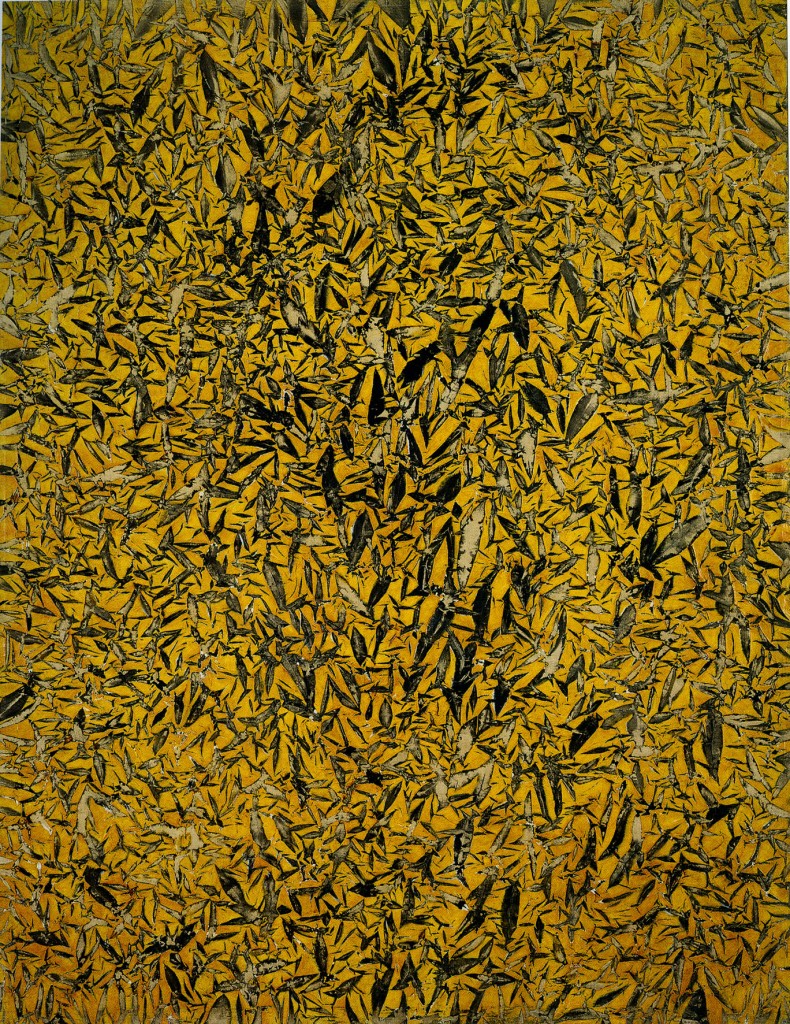
For the canvas in pliage is not a taut screen awaiting inscription, but obdurately physical stuff. Crumpled, redoubled, at times knotted, it exists as a variously three-dimensional volume, from light relief to pneumatic sack. Unfolded, however, that same, previously “sculptural” mass is revealed to be a painted surface—and more often than not, one traversed by non-painted reserves or “holes.” That Hantaï experienced that revelation as a new and more extreme version of the earlier Surrealist paintings’ menace of dispersion is suggested by a range of strategies that effectively mitigate the potentially disruptive nature of the non-painted: from his frequent use of black dripping (fig. 6), to near-monochromy, to repeated acts of folding and repainting that pulverize the borders between painted and non-painted, re-investing the whole with a new version of the earlier, palimpsestic density. That he also—and again as in the Surrealist work—found himself drawn to that menace is suggested by his repeated, though visibly hesitant, attempts to bring the non-painted back into play.
It is at this point that Hantaï takes what might appear a rather anachronistic turn, to the work of Paul Cézanne. Hantaï had looked at Cézanne’s work before, and in fact admired it deeply during his student years in Hungary.23 But that interest had gone largely underground during his Surrealist tenure and its immediate aftermath.24 In turning back to Cézanne now, he appears to have been seeking someone who might guide him deeper into the situation to which his work had led him: one in which painting appeared menaced by a certain thought or specter of flatness, and in which its hold on “the sculptural” had, in some sense, to be rethought.25
For Hantaï, this is a threat redoubled by the recent achievement of Jackson Pollock; while for Cézanne, it is of course Impressionism that raises that specter, and the story of his art—as has long been recognized—is largely a story about various attempts to hold on to or indeed recover some sense of the volume and solidity of things after their seeming dissolution in the work of Monet and other painters Cézanne admired. But precisely because he did admire them, Cézanne found himself compelled to paint within a situation—and within ways of seeing—transformed by Impressionism, and in which certain traditional means of conveying form now appeared closed to him. That sense of closure comes through clearly in a letter sent by the painter to Camille Pissarro in July 1876, which Hantaï cited frequently in his later years. In that letter, Cézanne, then working at L’Estaque, describes the intensity of the sun as producing contrasts so strong as to reduce all objects to depthless shapes:
It is like a playing card. (…) The sun is so terrible there that it seems the objects detach themselves from the background in silhouette, and not only in black and white, but in blue, red, brown and violet. I might be wrong, but to me it seems the opposite of modeling.26
That Cézanne could not, however, be content with depthless shapes is apparent in his famous rejection of Gauguin, as reported by Emile Bernard: “‘He didn’t understand me,’ he responded furiously. ‘I never wanted and never will accept the lack of modeling or of gradation; it’s nonsense. Gauguin wasn’t a painter, he only made Chinese images.’”27 Cézanne’s “solution,” as has been amply documented and discussed in the literature on his art, involves a rejection of modeling in a traditional sense—that is, as an effect of light-dark contrasts—and its effective reinvention as a matter of chromatic contrasts, as built up patiently through the repeated application of discontinuous, notionally “constructive” touches.
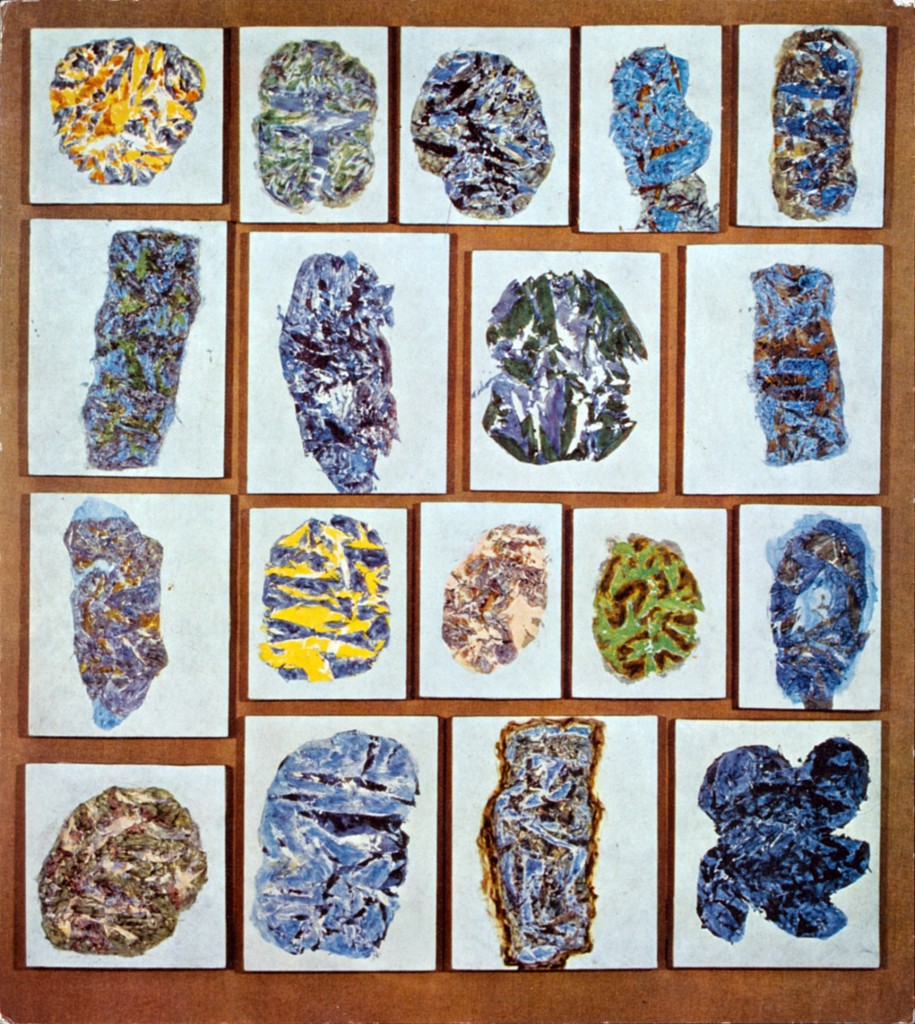
One early pliage series of 1963-65, called Panses, shows Hantaï experimenting with Cézanne’s method of construction by “petites touches” (fig. 7). Throughout this series, Hantaï refolds and repaints his canvas repeatedly within a relatively circumscribed and usually roughly central area. The results often appear as deflated or collapsed versions of the pneumatic-seeming and similarly biomorphic forms in Hantaï’s earlier peintures raclées. Yet these paintings no longer mobilize the light-dark contrasts that model the otherwise monochromatic forms in the two Femelle-Miroir pictures; rather, each act of folding and painting appears to have involved the use of multiple, often closely related tones: here a range of dusky plums, pinks, and violets; there a family of teal, turquoise, and cerulean blues. Sometimes he places these touches side by side, as if so many individual chromatic “cellules”28; more often, however, he layers them densely, or blends them with paintbrush or finger to create alternately subtle and striking local effects of relative recession and projection (fig. 8). Canvases of the former sort often let at least some nonpainted canvas peek through (a feature also apparent in Cézanne’s later work, but of which he despaired29), while those of the latter make of the painted areas surprisingly sculptural masses—forms as if cut out against the nonpainted far more than internally cut or interrupted by the nonpainted. Tellingly, Hantaï recorded a number of these works in his notes simply by drawing the contour around the painted area, the interior operations of the nonpainted being comparatively negligible (fig. 9).
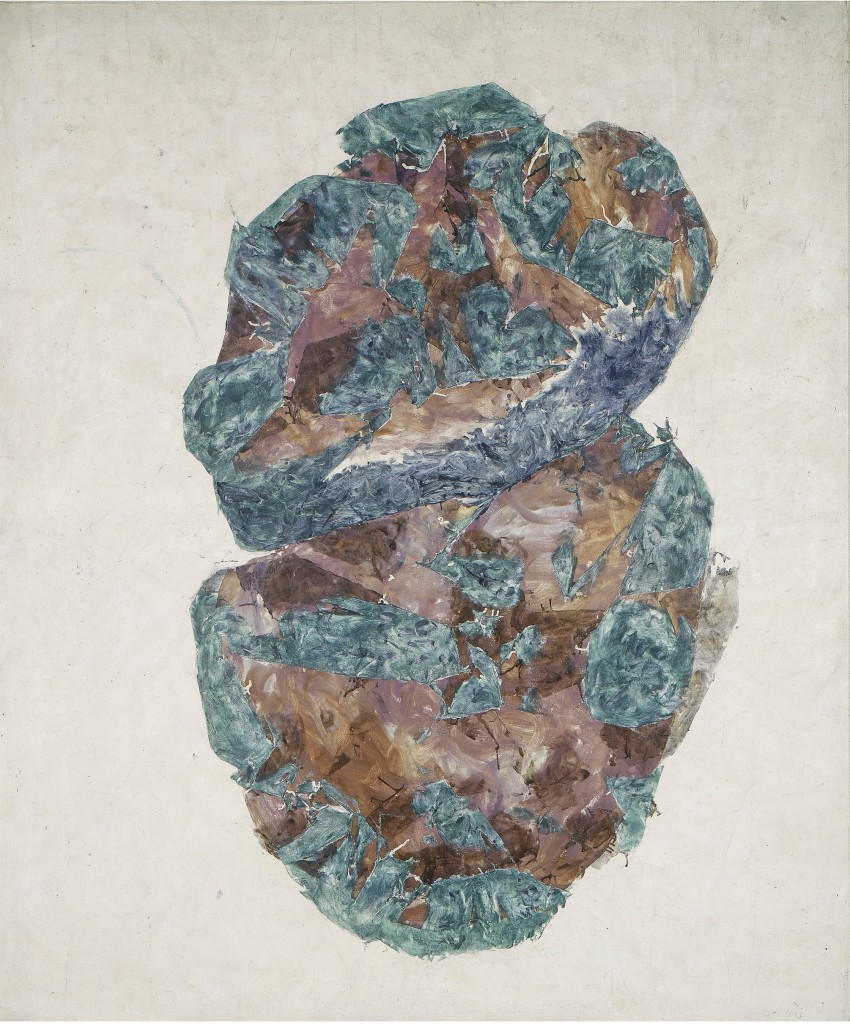
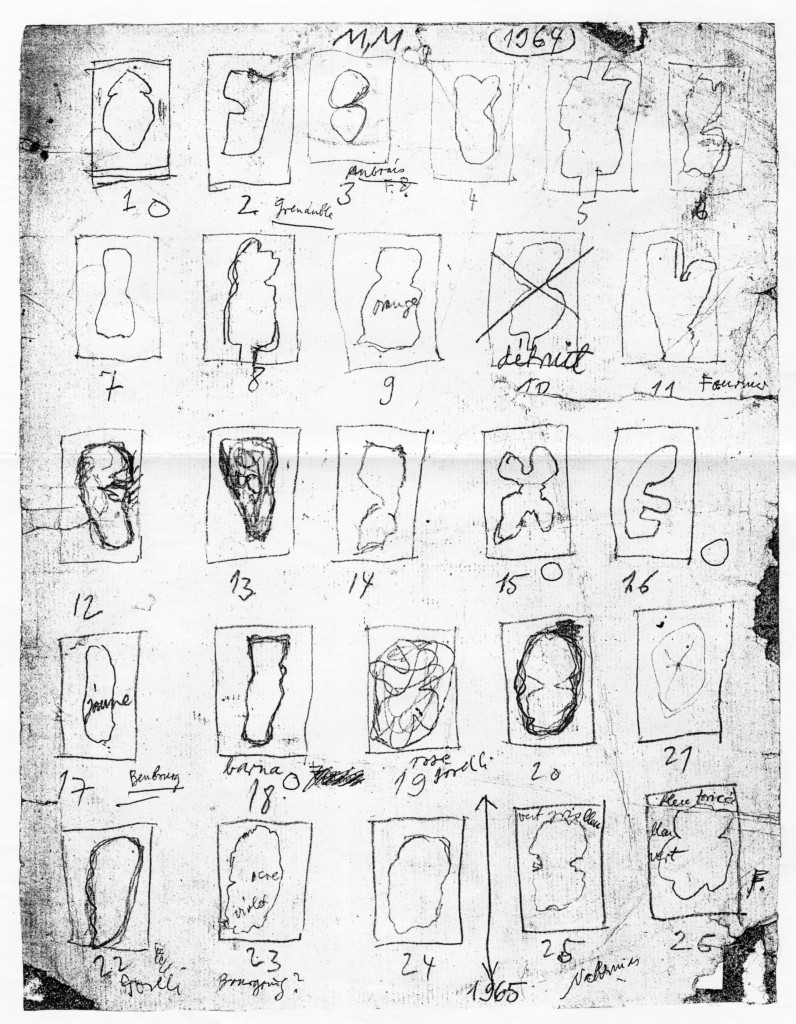

Not incidentally, a number of these painted forms also appear profoundly anthropomorphic (fig. 10)—even, in a handful of smaller Panses, portrait-like. Read against such forms, the encroachment of the nonpainted can appear as a threat not simply to the painted but, indeed, to personhood; it is a new avatar of the simultaneously wished-for and resisted release from human bounds of the two Femelle-Mirroirs. And as in those earlier paintings, the proliferation of “La Saucisse”—Hantaï’s original title for the series—reads as, in part, at once the symptom and the vehicle of a continued evasion or disavowal. That the early association of femelle body and painterly support remains vivid, if problematic, also is signaled by Hantaï’s titles: from the Mariales to the Panses, these repeatedly conjure feminine bodies and wombs in particular—perhaps not always sacred, but almost always “full.”30 Further evidence of his uncertainty: for the first and last time since his adoption of pliage procedures, Hantaï returns momentarily to working on stretched canvases—and covers them entirely with layer upon layer of painted touches.
III
Hantaï’s dealings with these issues might have remained there, had they not been interrupted and transformed by another, closely related movement of redoubling and new recognition. In 1967, Hantaï was named the first-ever laureate of the Fondation Maeght, in Saint Paul, in the South of France. While in residence there to prepare his subsequent exhibition, Hantaï also took time for two key trips: to Aix-en-Provence, where he saw both Mont Sainte-Victoire and Cézanne’s studio at Les Lauves; and to nearby Vence, where he visited Matisse’s Chapel of the Rosary. As he was with Cézanne’s, Hantaï was of course familiar with Matisse’s work already: indeed, the Musée national d’art moderne’s 1949 exhibition of the master’s late papiers découpés had been among the first shows he had seen upon arrival in France, prompting him to make several small-scale works of his own employing cut-out and stenciled forms. Nonetheless, that early approach had remained without consequence during and in the wake of Hantaï’s Surrealist tenure. It is only in 1967 that Hantaï appears to have been ready to consider Matisse’s work anew; but this second encounter transforms his practice altogether. What Matisse shows Hantaï, in short, is a new means of “carving into color” oriented less to the presumed density of things-in-themselves than to the lateral rapports that at once link and divide them. And it is in light of that fundamental shift that Hantaï is able, in turn, to embrace pliage as a medium in which the reserve of painting—the “lack” associated since Femelle-Miroir I with the title protagonist’s displaced “mirror sex”—ceases to register simply as form destroying, and becomes fully implicated instead in a larger play of spacing.
That the passage in question was experienced as difficult, indeed menacing, by Matisse himself is among the central claims in a defining essay by Georges Duthuit. In 1958, the art historian—who also was Matisse’s one-time son-in-law—published “The Carver of Light” in the last of several special issues of Verve devoted to the recently departed master.31 There Duthuit begins by situating the papiers découpés more or less as Matisse himself did—which is to say, as the culmination of a lifelong quest to construct through color contrasts alone, such that “the work is born of the pure confrontation of colors.”32 He then describes a crucial shift in the overall development of Matisse’s approach to color, having to do with what one might call the “delivery time” of the chromatic contrasts in question. Earlier works by the master, Duthuit claims, inevitably conjured a durée; and that durée was on the side of density:
At the time that Matisse painted The Dance and Music, these large surfaces delivered of local tones certainly existed, but the course of the paintbrush insinuated its highs and its lows, its moments of assurance and of hesitation, of quickening and of turning back. It wove from them, touch upon touch, a fabric of acquiescences, of conciliations, of joys, that loosened the inertia of the canvas, and allowed it to palpitate, to respire. It had, in all its frankness, an unfolding: the labor of the painter in time, going against routine, modulating space by his effort, rediscovering by virtue of that effort volume and depth.33
All of this, however, Duthuit takes to have changed with the papiers découpés Matisse began making in the 1940s. There Matisse cut directly into the already present color of his gouache-covered papers, “modulating” that color through contour alone—or more precisely, through the “measuring” of differently proportioned and shaped areas of color. In a further, central passage, Duthuit picks up on, and glosses at length, Matisse’s own likening of the cutting of the papier découpés to the “direct carving of the sculptors”34:
Is it not the first time, in fact, that the technique of statuary is applied to the substance of painting? The artist carves in a block that is no longer sandstone or marble, but chroma. He therefore assigns himself an onerous task, for color does not lend itself easily to sculptural treatment.
[…] He must imagine a language in which to continue to say weights and measures. Similarly, the former means of marking distances, and therefore of aerating the work, no longer offer him the least help; and yet, the work must continue to breathe. Matisse finds himself in the situation of an organism suddenly required to modify radically its breathing apparatus, to substitute for lungs a system of gills. The work now respires thanks to a subtle play of expansions and contractions, entirely due to the configuration of forms, since the flatness of the plane and the integrity of the color are without recourse.35
Duthuit frames this passage as, above all, an experience of exposure; indeed, of lucidity almost to the point of excess: “if there is strangeness here, it is not the strangeness that proliferates in the reserves of obscurity, but the strangeness of light…[that] invades our innermost being.”36 That light—“exterior, physical, or rather natural”—appears less as a complement to what Duthuit calls its “age-old guarantor, the light within,” than as a threatening element in which the latter risks dissolution37: “If the most intimate aspect of being receives access to liberty, it is only to feel itself just as soon dissipated by that liberty, just as pockets of humidity evaporate when exposed to the burning heat of summer.”38 Matisse moves toward that light as toward his peril.
A blue and green Meun of 1968 shows Hantaï retracing and renewing this passage on his own terms (fig. 11). The painting is one of several “transitional” or “uncertain” Meuns that show the painter beginning once again to divide tone, as he limits himself increasingly to one color per area of the canvas or even per act of folding, painting, and unfolding. Like the great decorative panels by Matisse cited by Duthuit, the work begins to suggest an expansive quality that will be one of the hallmarks of Hantaï’s later pliage work. But also like those panels, it reveals internally variegated fields of highly legible brushwork—a luscious painterliness facilitated by Hantaï’s use of extremely liquid oil paint, and which introduces a sense of palpable volume into many of the painted areas. That effect is further enhanced by the addition of blue paint around the edges of green areas to the lower left and upper right: as in so many works by Cézanne and the earlier Matisse alike, that addition appears meant to suggest a turning of forms in space. Such effects show Hantaï, like those predecessors, straining against the potential collapse of painting into the “playing card.”
Yet this same work reveals other, deeper transformations nonetheless taking place in Hantaï’s art: in particular, the interruption of the painted forms by variously shaped and proportioned areas of nonpainted canvas. Breaking the continuity of the painted, those areas draw our attention from what one might call the “internal” modulations proper to any one painted area, toward the “overall” modulation of the surface as a whole by all the forms, working at once in concert and against the total, nonpainted field in which they appear.
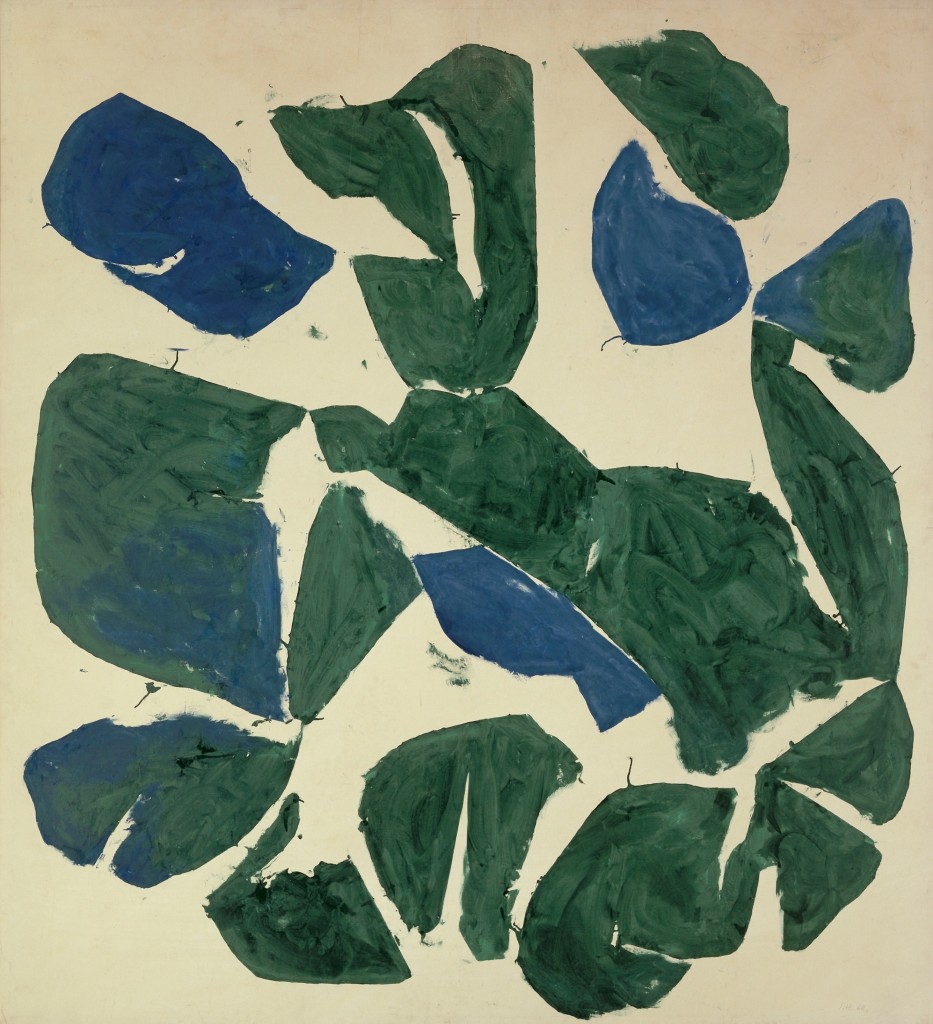

What the work shows, in other words, is Hantaï’s learning a fundamentally Matissean lesson: that the work of art is constituted entirely by rapports.39 This recognition is what allows him eventually to move toward comparatively unmodulated aplats, as also toward higher-keyed color—a shift soon confirmed and carried forward by the immediately subsequent Etudes (the availability of acrylic paints also plays a role in this story). A lemon-yellow Meun of 1968 is especially daring in this respect: no hue could be less adapted to picturing density, yet the forms do indeed breathe and turn, aerated by the variously proportioned slivers and expanses of nonpainted canvas (fig. 12). The work is made fully of those ever-changing contrasts between painted and painted, as between painted and nonpainted.
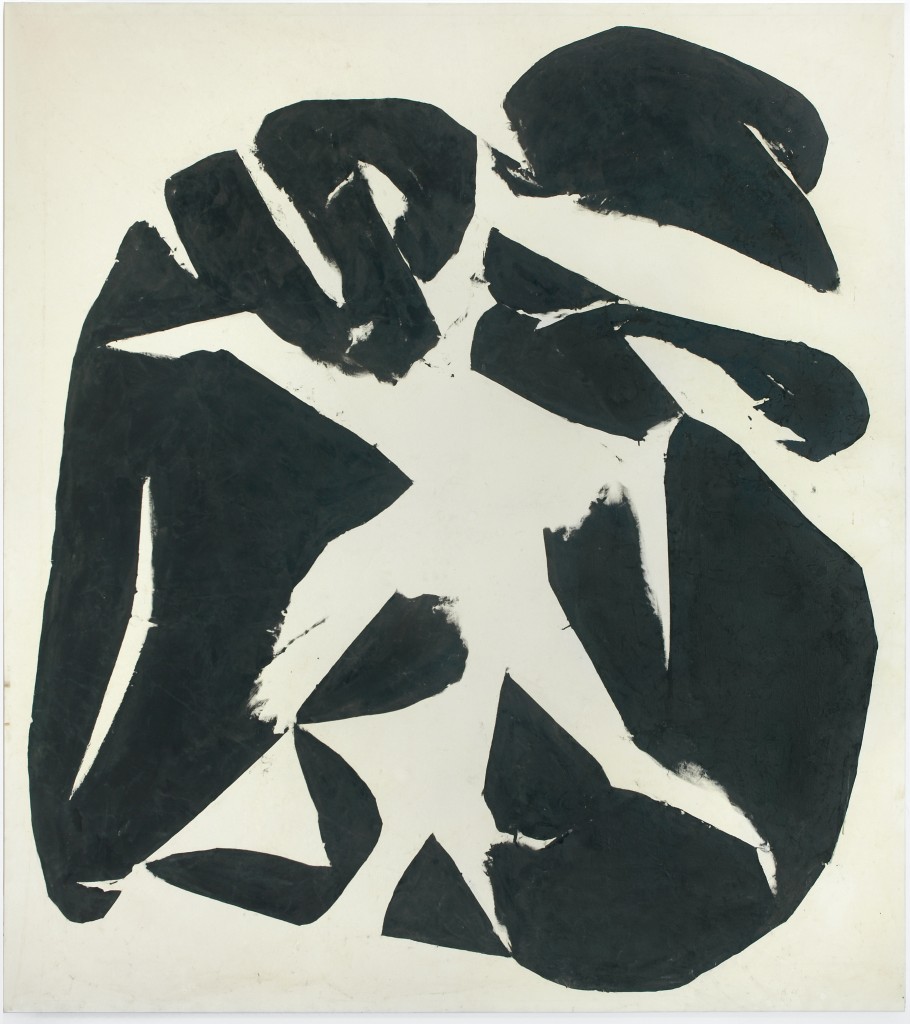
That recognition also proves enabling for Hantaï in another, larger sense: it proves the liquidation of his longstanding resistance to the femelle body as that which lacks a solid “center” or “core.” Indeed, one of the most striking developments in the overall elaboration of the Meuns concerns Hantaï’s gradual shift from choked or crowded to increasingly aerated centers (fig. 13). Read against the backdrop of Hantaï’s earlier negotiations with Surrealism, his acknowledgment of the nonpainted suggests an active submission to precisely that menace of dispersion at once staged and denied in Femelle-Miroir I and II. That the painted forms in so many Meuns appear as later avatars of the earlier femelle’s exaggerated buttocks, breasts, and cleft sex appears to me to support this view (figs. 14-15) —as does a no less striking structural rhyming of so many nonpainted “stars” with Femelle-Miroir’s jagged maw.40 These references can at times be a bit too close to the surface (fig. 16). But the better Meuns are those that appear held together in a kind of precarious and contingent syntax, their forms no longer subordinate to the dictates of recognizable figuration but as if keyed to the dispersed, diffuse, and notionally impersonal bodiliness of the canvas “itself.”
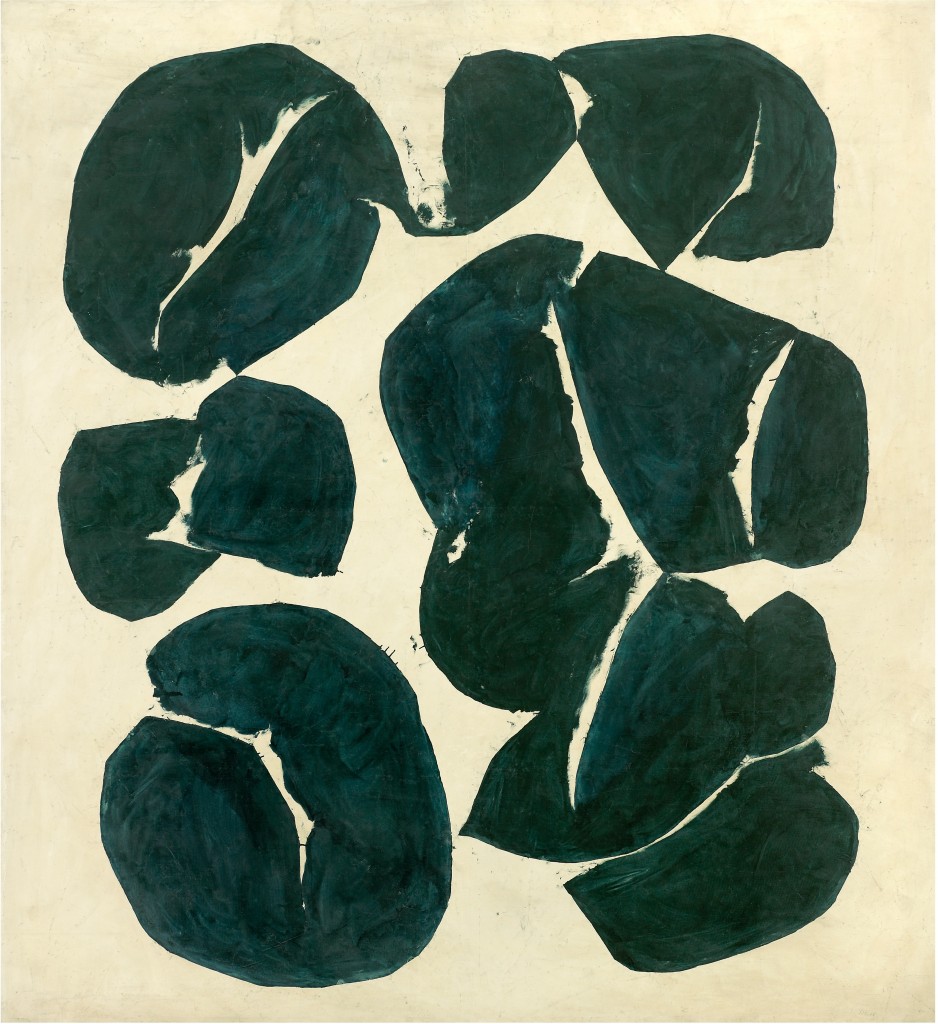
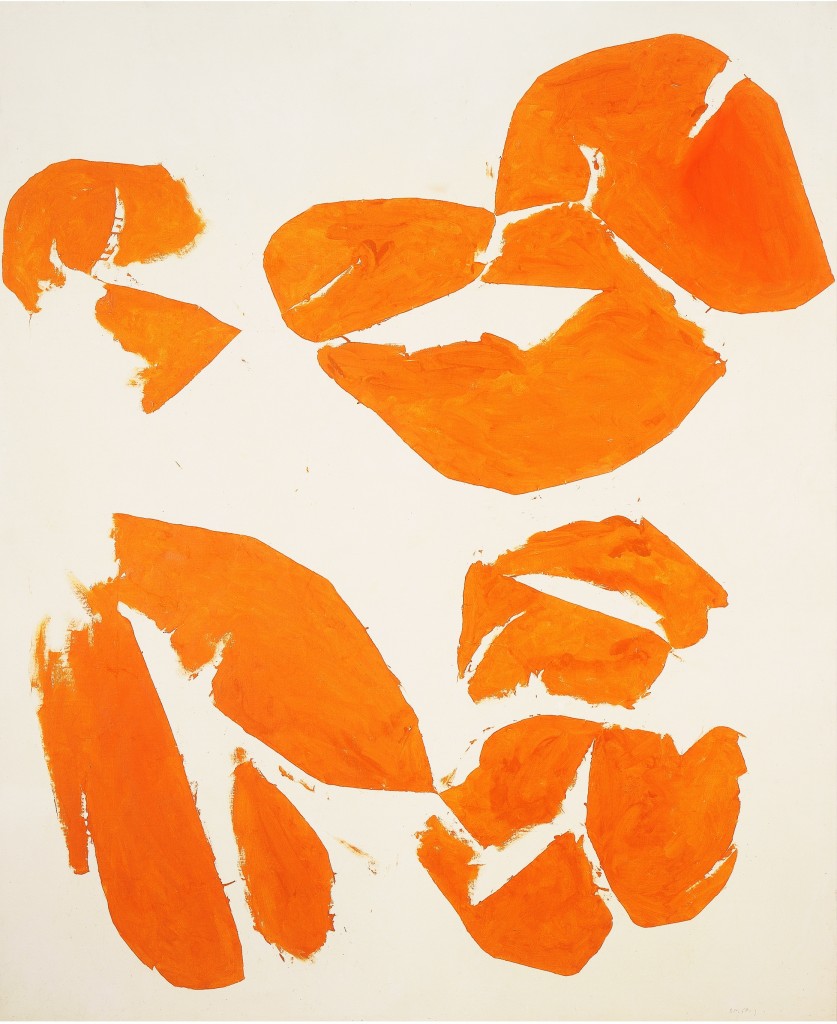
The acceptance of that dispersion is perhaps the central event of the Meuns as a whole, what divides this series crucially from Hantaï’s earlier pliage work. Palpable in the increasing dynamism of Hantaï’s painted configurations over time, it also is dramatized on the level of each individual work: in the unfolding of the painting from the pouch-like volume it had been, which also is the shattering of the continuity of the painted. The Meuns assume fully that passage toward surface—a passage that in some respect literalizes Duthuit’s description of Matisse as moving from “the reserves of obscurity” toward a “light…[that] invades our innermost being,” even as it also gives that passage over to a play of repetition and transformation. That this passage was perpetually at stake is suggested by Hantaï’s summation of the choice with which he took himself to be faced before each folded canvas: “Whether to unfold it, or to leave it in mountain-form.”41 (I take the “mountain” here as an allusion to what this practice continues to owe to Cézanne.)
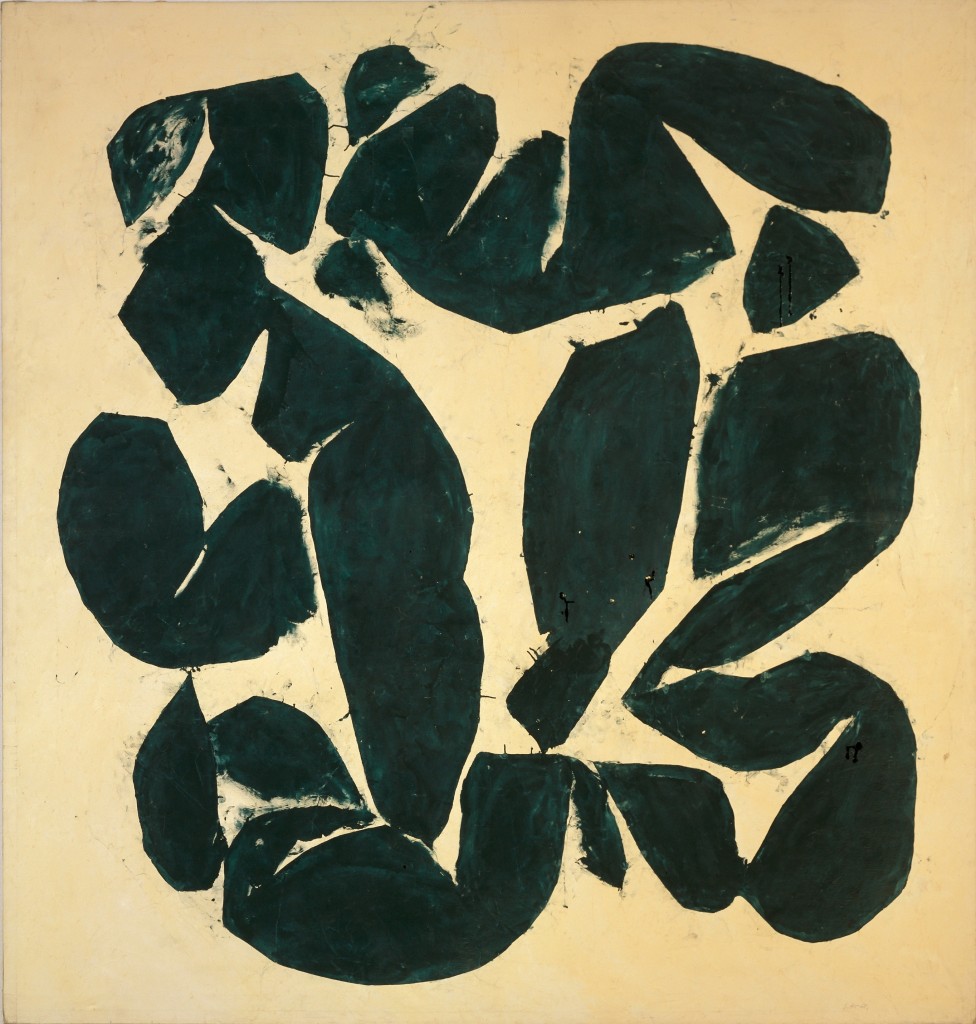
A number of Meuns bear visible reminders of that “sculptural” moment, of the pouch-like forms from which they emerged. Indeed, many virtually invite the beholder to reconstitute their folded forms, the rounded “mountains” they once were. In so doing, they take over some of the force of effects previously made possible in the papiers découpés by the continued role of mimetic reference—the ways in which the 1952 gouache Venus, to take just one example, is able to imply foreshortening through cut contour alone.
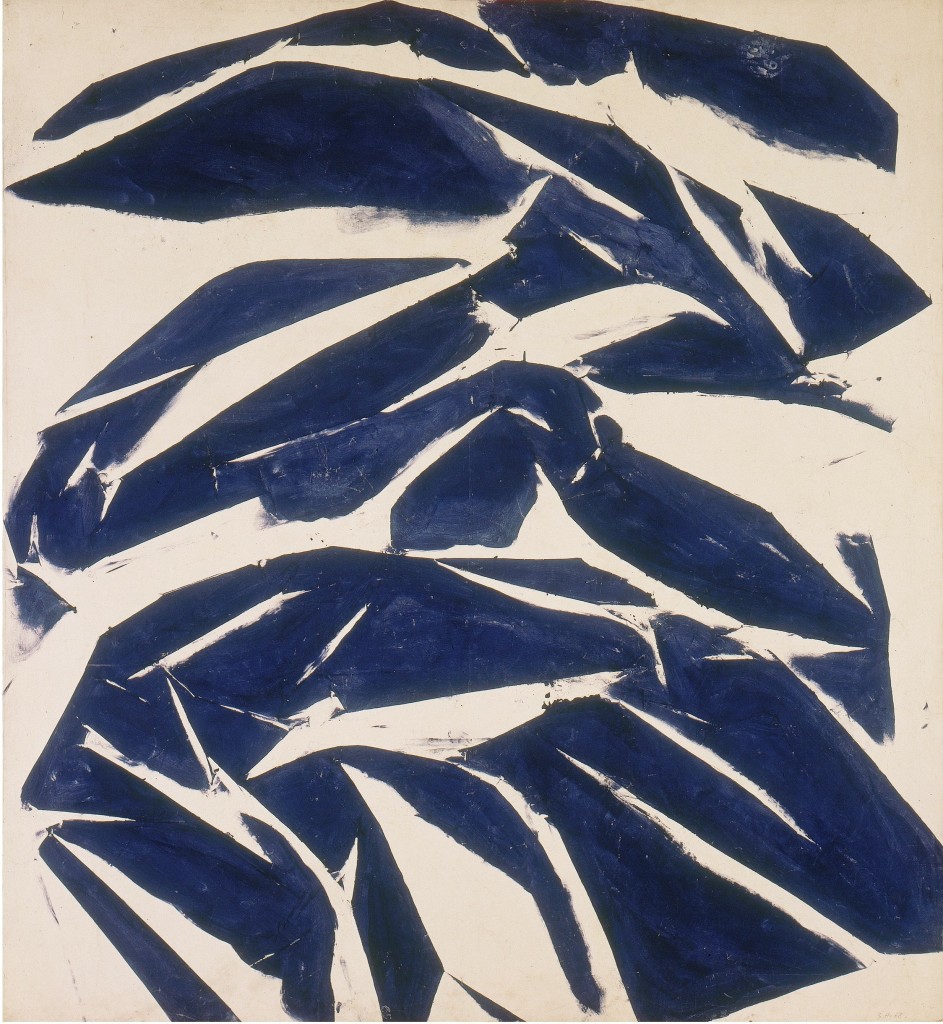
But this also brings us to a key difference between Hantaï and Matisse. Where the latter draws his impetus from external models, Hantaï draws his from the materiality—the “body”—of the canvas itself. This can seem like, and often is viewed as, a kind of “literalism”; but Hantaï’s own remarks lead in a different direction, attributing that support an unprecedented degree of agency and selfhood—even, indeed, something like desire. Hantaï does not cut into his canvas; rather, that canvas “cuts in itself … invaginates and hides itself.”42 That “self-cutting” action is further dramatized by an overall passage from the rounded paint areas of earlier Meuns to the increasingly slashing and shard-like forms of later iterations within that series and, indeed, all subsequent series (fig. 17). That the results of that action were never entirely foreseeable for their author is but one mark that painting remains, for Hantaï, crucially bound up with obscurity.
IV
Hantaï’s experience of the nonpainted frees up an impetus at least implicit, if not fully available to him, in his practice since his Surrealist tenure: from now on, he approaches the canvas not only as a “body” in its own right, but further, as a desiring body; indeed, one whose desires often are opaque. If Hantaï experiences that new situation as, in part, liberating, it nonetheless raises more questions than it answers. In particular, it means that he now finds himself asking not simply what he wants from painting, but also: “What does painting want from me?”43
This is, to say the least, a rather peculiar and phantasmatic position in which to find oneself; and Hantaï’s question, as he well knew, seems to exceed the limits of art history. But nor is it simply idiosyncratic. Rather, it might be understood as the translation, within a practice that is now understood as deeply libidinally charged, of among the most important questions in contemporary psychoanalysis. In particular, Hantaï’s question finds an especially significant and illuminating analogue in the writing and teaching of Jacques Lacan, with its concerted rethinking, with and beyond Freud, of the topic of feminine sexuality (Freud’s infamously puzzled “Was will das Weib?”—“What does woman want?”44). Significantly, Lacan has traversed much the same Surrealist culture as Hantaï; and he too is critical of the movement, on not unrelated grounds.45 He can provide suggestive lenses onto—even, at times, unintentional glosses on—defining aspects of the problematic sketched so far.
The key issue concerns Lacan’s insistence on rethinking sexual difference within the context of a “return to Freud” in which castration figures centrally. This insistence is integral to Lacan’s critique of American psychoanalysis and what he sees as its tendency to naturalize differences between the sexes, rooting them in brute biological fact. Against this tendency, Lacan points to what appears, in Freud, as the essentially psychic construction of these differences, recasting the castration complex as a drama about the ways in which human subjects discover themselves through language—and discover themselves, crucially, as exposed, mediated by otherness.
The charting of these negotiations is central to Lacan’s later work on feminine sexuality, and particularly his 1972-73 seminar, Encore. There the psychoanalyst introduces a now well-known diagram, ascribing each of the two sexes one of two sides, each of those sides mapped in turn by two different propositional formulas.46 The detail of Lacan’s scanning of those propositions reveals all the difficulty and density characteristic of his later writings, but the basic point is simple enough: Lacan sees “masculine” and “feminine” as, critically, something like two different stances or positions one might take up. “Every speaking being,” he stresses, “situates itself on one side or the other” (Lacan, 79); yet nothing prevents a woman from taking up a place on the masculine side, nor a man from finding himself on the feminine side. And this is possible precisely because one’s sex is not a question of biology, but rather, of a particular way of negotiating questions of unity and selfhood.
Nor do the sexes divide as plenitude to mere lack, the masculine finding itself in a fullness of presence denied the feminine: both are subjected to what Lacan calls the “phallus,” marked by and mediated through it. Both sexes dream of a position outside the play of contraries that compose them (the dream, then, of a subjectivity without reserve47); but they dream it differently. In Stephen Melville’s useful gloss: “the masculine position is one that thinks—poses—itself punctually and directly: ‘I am’ (for example) ‘not a slave’; whereas the reserve of feminine subjectivity asserts itself only mediately, through a unity which it is not: ‘Not all women are slaves (and I am not all).’ It is this ‘not-all,’ pas-tout, that Lacan takes to define woman” (Melville, 95). The differences between the sexes are, as it were, grammatical differences.
Lacan’s insistence on castration offers a new context in which to consider Hantaï’s passage beyond Surrealism. Breton, we might say, never ceases to dream of a unified self, free and undivided: that is the self he was seeking in the “mirror sex” with which Hantaï’s negotiations with the movement in some sense began. But what opposes that fantasy in Hantaï’s earliest Surrealist work—and what eventually supersedes it altogether with the move to pliage—is a deep, if initially inchoate, sense of the fact and claims of medium: that there is no language that does not originate with others, and whose “laws” one can do no more than inhabit and appropriate. (Against Breton’s defining early conception of Surrealist automatism, then, a medium would be a “language” emphatically with reserve.48) Pushing this further, one might then say that “sculpture” and “painting” line up for Hantaï roughly as do “masculine” and “feminine” on Lacan’s chart, sculpture being that which “thinks—poses—itself punctually and directly,” while painting is marked from the first by a fundamental reserve, and therefore “asserts itself only mediately, through a unity which it is not.” Like Lacan’s woman, painting for Hantaï comes to be defined by its condition of pas-tout, “not-all.”49
Hantaï’s early pliage work often appears to stage something like the discovery of difference and the castration complex in a way that can feel not simply knowing but self-deprecating. So for example he multiplies phallic forms throughout the Panses, and puts himself explicitly in the position of the child in that series’ plaintive original title, Maman! Maman! dits: La Saucisse. (Asked about that title, Hantaï responded drily: “You can see this guy is lost.”50 Not for nothing does he use the third person here, as if further depersonalizing this drama.) By contrast, Hantaï in his later years privileged an unmistakably Oedipal trope for his reversal of fortune in pliage: through folding, he claimed, he “put out” his eyes.51 The nonpainted reserves that come to the fore from the Meuns forward are at once the mark of and the figure for that blindness—the constitutive nonmastery—in the act of painting.
It is as if psychoanalysis provides Hantaï an allegorical context in which to think through the problems of painting. By the same token, the daily practice of painting might be understood as functioning for Hantaï as itself a “therapeutic” practice of sorts. This idea too has roots in Surrealist associations of the practice of automatism with “spiritual exercise,” but the practice that interests Hantaï leads away from integration of the self, toward a more difficult figuration of the fundamentally split and knotted nature of subjectivity.52 Roughly put, painting is imagined by Hantaï as performing something like the task of the Lacanian analyst: it brings him (the “analysand”) to recognition of his finitude and contingency.
V
The catalogue for Hantaï’s 1976 retrospective at the Musée national d’art moderne offers a further taking-up and transformation of these issues. Indeed, its striking layout—which was designed by Hantaï himself, with help from his longtime dealer, Jean Fournier—begins by presenting an implicit “origin story” of sorts for Hantaï’s pliage practice; and like all good origin stories, it is no less powerful for being mythical. That its very staging appears to have gone largely unremarked is perhaps but a further testament to that power.53
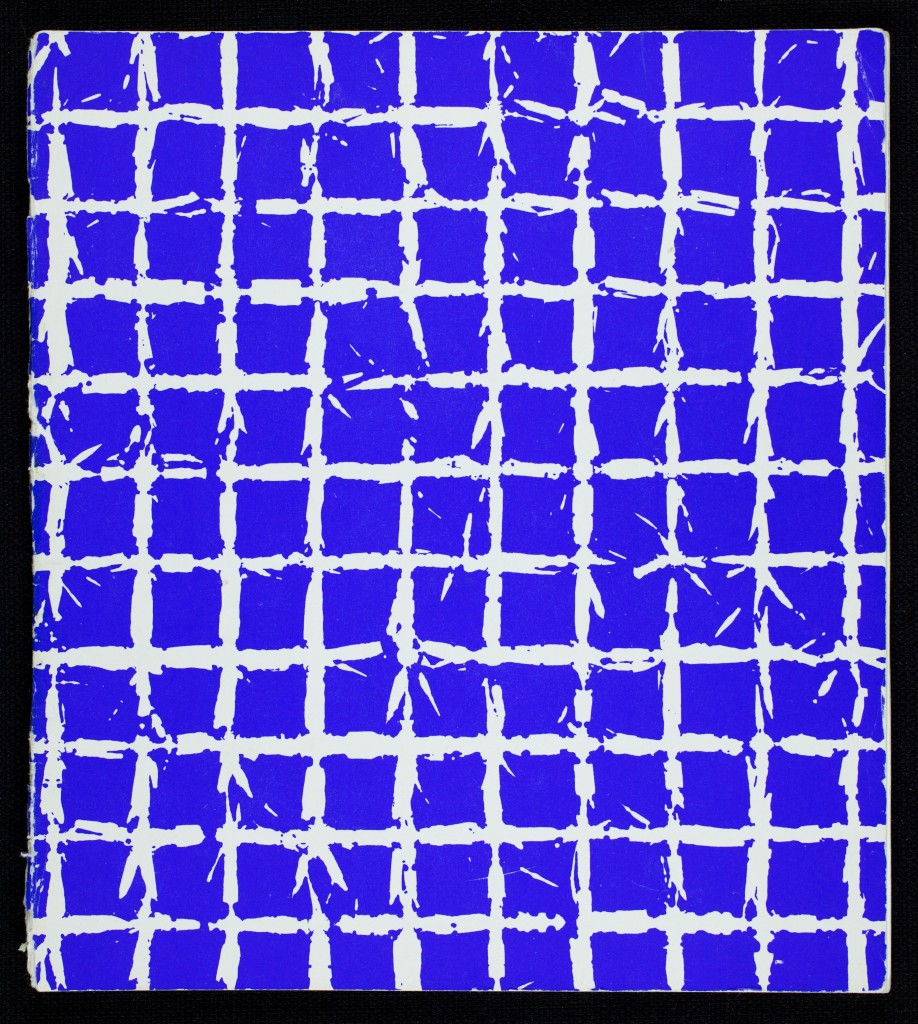
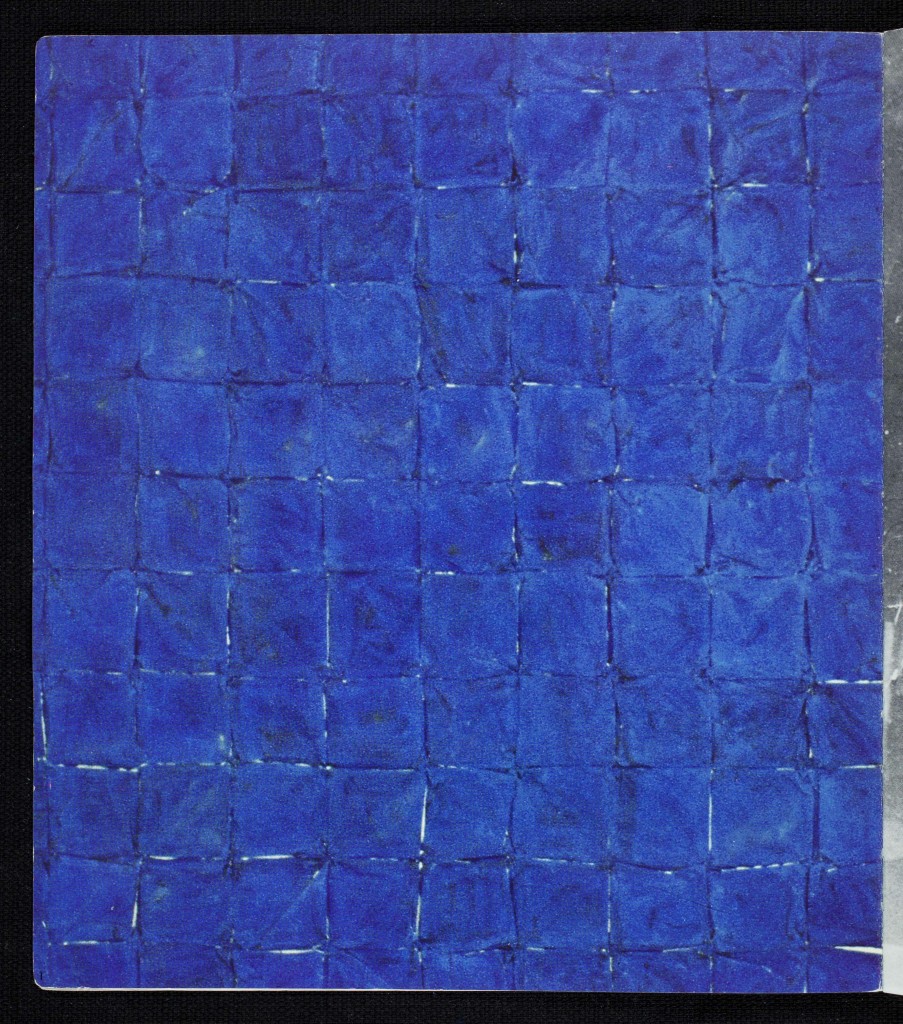
On the cover of the catalogue appears a silkscreen detail of a large painting of the sort Hantaï had begun making in 1972, which he called Tabulas (fig. 18). Like the Meuns, it too is a late descendant of Femelle-Miroir I; but unlike the Meuns, it shows Hantaï turning his attention from the biomorphic shapes variously gathered and dispersed throughout that peinture-mère to its gridded ground and dark painted square (the depicted “mirror”). That earlier ground is even more powerfully conjured by the second image in the catalogue, showing a detail of a Tabula prior to unfolding (fig. 19). But that is not the comparison encouraged by the catalogue. Femelle-Mirroir I was in private hands in 1976, and neither it nor its pendant was included in the MNAM show. Instead, what Hantaï offers—in the place of the third image—is yet another Femme-Miroir: a grainy, black and white photograph of his own mother, circa 1920 (fig. 20).54 She gazes directly at the camera, the lower half of her body covered by a dark, gridded, and apparently reflective cloth (note the multiple gleams of light): her impeccably pressed tablier.
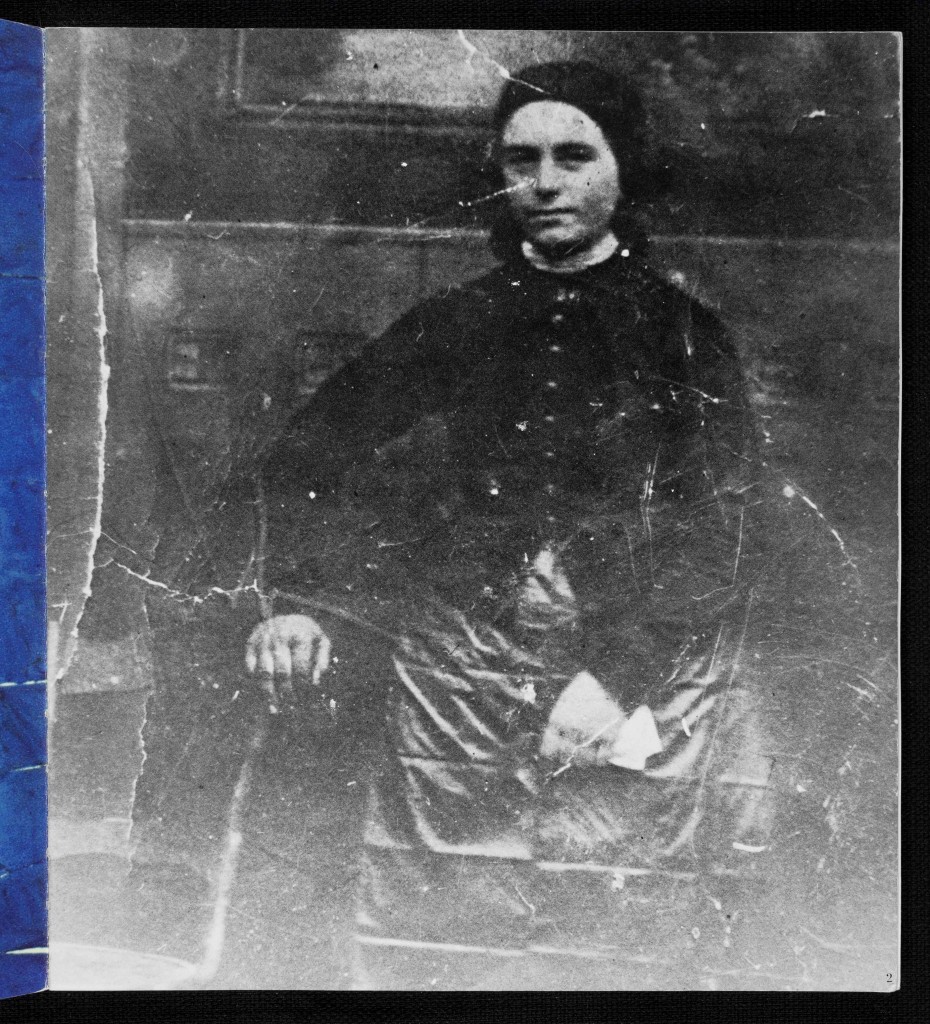
Much ink has since been spilled about that tablier, which has become a highly auratic object in its own right.55 My interest, however, is less in the thing itself than in the function it serves in the story Hantaï is telling; and that story is a Freudian fable of the discovery of difference. Regressing through time—from open Tabula to closed Tabula—we find the powerful figure of the mother, her tablier as if commanded by Freud, the better to stoke the child’s curiosity about what lies behind.56 That we are indeed on a path of this kind appears confirmed by the following image, a detail of a 1949 painting by Hantaï of nine female bathers in and alongside a river, unclothed but holding various cloths—and among them, yet another gridded cloth (fig. 21).
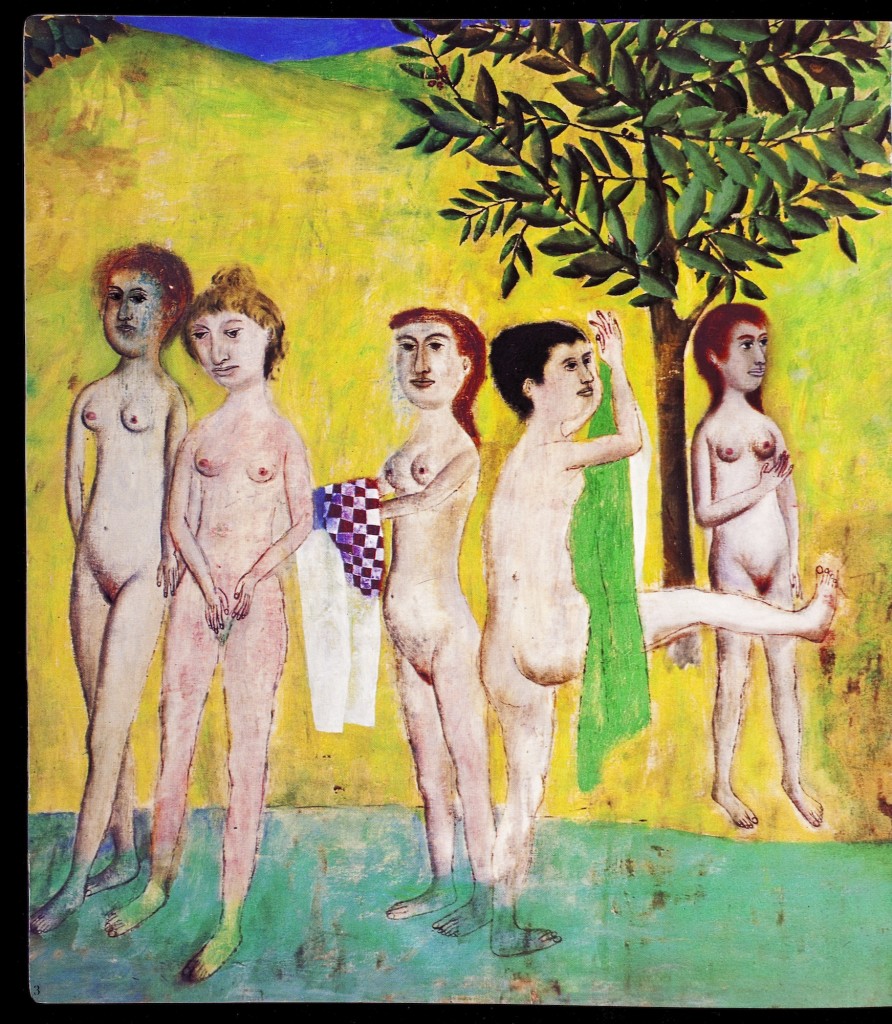
The scene is set; these various moments have only to be charged retroactively. And indeed, the next few images suggest the irruption of a sudden threat, the shattering of that quiet world by the river: from an allover painting of interlocking forms we pass immediately to a 1952 painting of a monstrous figure with a cruelly amputated arm and blown-open stomach, its pose presaging elements of both Femelle-Miroir I and Femelle-Miroir II (fig. 22). Then it is a new and alien world: a world of viscera and entrails, bodies in parts, horror vacui (fig. 23). Pliage emerges within and against this context, letting the air back in.
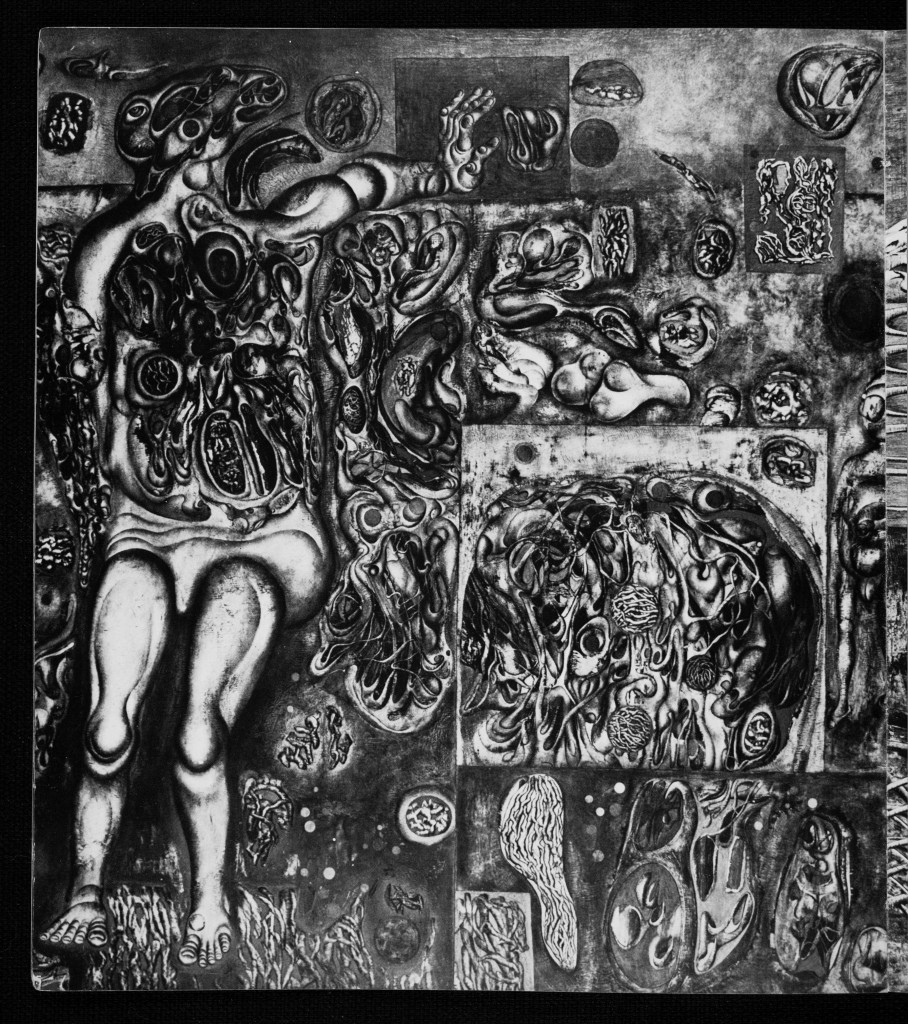
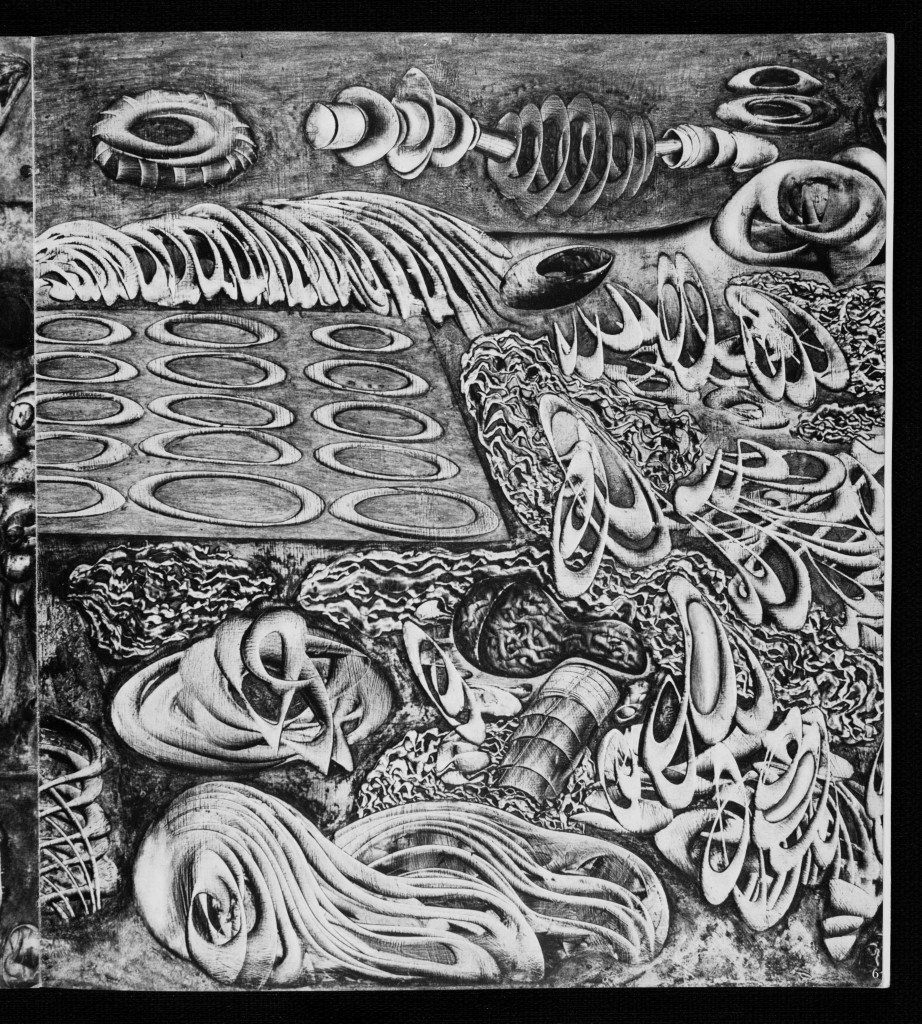
One could pursue this reading indefinitely, each new image conjuring further constellations of associations, new sites from which to gather up Hantaï’s work. That interminability is the very point. For what Hantaï is conjuring, in showing this story, is the birth of a self riven by difference, conditioned by limits not of his making, one that will always have an “obscure part”—a monster to himself. This is, for Hantaï, the kind of being who makes paintings. Pliage is born of that monstrosity, engendered by it.
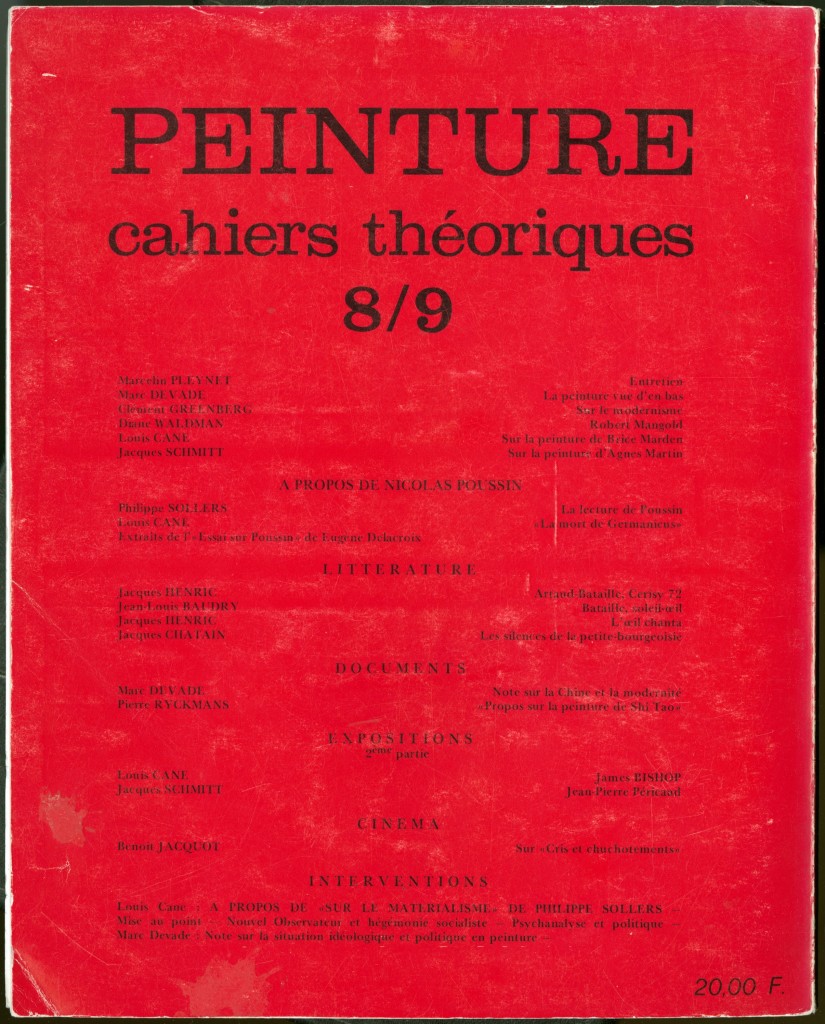
Hantaï had, of course, been saying something like this all along. But by 1976, there were new reasons for saying it. The writings of Clement Greenberg were increasingly available, American minimalism increasingly visible (fig. 24).57 Presented in France as an “Art of the Real” (as in the 1968 exhibition by that name at the Grand Palais), this work defined a new context in which the pressure of “the literal” was making itself felt with renewed force. Indeed, the Tabulas themselves take over structures and strategies broadly associated with minimalist art, from serial repetition to Hantaï’s version of “deductive structure” (to take up a well-known term from Michael Fried’s writing on Frank Stella). Yet they take them over only to show their deformation from within, the rupturing of their structures by the always-unforeseeable workings of desire. Call this the mutual entanglement of symbolic, imaginary, and real; or just call it pliage as method. It will not be named once and for all.
Notes

I have taught things that made no claim to transgress anything, but simply to define a certain number of knots, points of impossibility. –Jacques Lacan, … ou pire
In the catalogue for Simon Hantaï’s 1999 retrospective at the Westfälisches Landesmuseum für Kunst und Kulturgeschichte in Münster, Germany, there appear reproduced, side-by-side on a single page, two paintings that also were placed adjacent to one another within the show itself (figs. 2-3).1 Both are from 1968 and belong to the series called Les Meuns, after the tiny hamlet near the Forêt de Fontainebleau where Hantaï recently had established a studio-residence. The paintings are of similar dimensions, being just slightly taller than the standing human form, and very nearly square. Comparable, too, is the overall disposition of painted forms: both reveal quatrefoil, roughly lobed shapes—one lobe in each quadrant of the painting—and both are similarly marked, in the upper right quadrants, with downward-slashing diagonals of nonpainted canvas. Clearly, the two paintings form a couple.


But as many couples do, the two paintings also reveal striking differences; indeed, they appear differently sexed. There is, to begin with, that oblong form between the black Meun’s two lower lobes. Not only is it missing from the brown Meun, the latter painting’s midsection is traversed instead by long, horizontal slits. Once noticed, the overall impression before both works is of an exaggerated, almost cartoonish figuring of masculine and feminine anatomies. Given Hantaï’s highly active participation both in the preparation of the Münster catalogue and in the installation of the show itself, something of the artist’s own, barely suppressed laughter seems to echo from this pointed pairing.
That laughter, might one share it, would also be a challenge. For humor is not a quality often associated with Hantaï’s art. Born in Bia, Hungary, in 1922, and active in France from 1948 until his death in 2008, Hantaï is revered as one of the most important figures in French art of the later twentieth century. A member of André Breton’s Surrealist circle in the early 1950s, he also became, in the course of that decade, one of the first artists in Paris to notice and respond to the work of Jackson Pollock and other American Abstract Expressionists. Beginning in 1960, he developed what has come to be known as his pliage “method”: essentially the painting of a crumpled, folded, or knotted canvas that is then unfolded and stretched for exhibition.
The Meuns generally are taken to mark a key crux in the pliage work—at once the onset of Hantaï’s mature reckoning with a prior French tradition in which Cézanne and Matisse figure crucially, and, by that same token, the definitive overcoming of Surrealist outrance by modernist discipline. The dominant narrative of Hantaï’s trajectory, as summed up by Musée national d’art moderne director Pontus Hulten on the occasion of the artist’s 1976 retrospective at his institution, is that of “a sublimated vision,” passing from “a sort of visionary humus” to “a new life of painting, rooted in light.”2 The later Hantaï is a painter of light, not bodies; his forms so definitively depsychologized as not to be properly intended at all. And yet…
Black humor, at least, did play a marked role in Hantaï’s earlier art and his framing of it: this is, after all, the same painter who dedicated his first solo exhibition after the break with Breton to Jean-Pierre Brisset, a nineteenth-century grammarian best known for claiming that the discovery of sex was the “first excess,” indelibly recorded in vertiginous and often stupefying puns lurking just beneath the surface of ordinary language.3 And as the two Meuns in the Münster catalogue appear determined to remind us, references to sexuality, and feminine sexuality in particular, recur in the later pliage work, as they recurred in Hantaï’s own comments about his art. Later in life, Hantaï often forced the issue, claiming to spend his days in the studio “spreading vaginas”—a reference to the folds of his unstretched canvases—and describing his glorious first pliage series, the Mariales, as keyed to what’s “under” the Virgin’s skirt.4 Many of these comments doubtless were meant to provoke and discomfit, and run their own risks of banalizing what was, from first to last, an extraordinarily complex and searching practice. But they also were consistent with Hantaï’s larger commitment to “impurity”—a commitment that was, itself, at once ethical and polemical, deeply held and willfully deflationary.5 That commitment remains largely unaccounted for in the existing narratives of Hantaï’s art.
This essay advances a new story—one aimed at rethinking the relation of Hantaï’s later pliage work to the earlier Surrealist excesses, and at the recovery of deep continuities among the more evident ruptures. Of special interest to this account is the role of “the feminine” (or better, “femellité”) in Hantaï’s work and thought from the 1950s forward. Hantaï is a key figure for modernity precisely because he brings together two major problematics we tend to think of as distinct—the Surrealist exploration of sexuality and the modernist investigation of medium—and makes them mutually driving for his art. In so doing, he also provides a powerful response to then-emerging narratives of modernism as a drive toward “flatness” or “the literal,” pointing toward a more difficult and nuanced vision of painting as a medium.
I
Some time in the course of 1953, while Hantaï was an active member of Breton’s group, he painted two canvases called Peinture (Femelle-Miroir I) and Peinture (Femelle-Miroir II) (figs. 4-5).6 Despite their sequential titles, the paintings probably were worked on more or less simultaneously in the studio, and the “I” and “II” might be taken as reflecting something more like conceptual or mythical than literal succession. Each painting turns upon a central figure—presumably, the title’s Femelle—painted, for the most part, in sickly, acid green tints; and each portrays that figure before a real or suggested mirror. Both are fairly large for Hantaï at that time, with Femelle-Miroir I standing slightly taller, and both were produced through controlled acts of raclage, a technique that involved applying paint to the canvas and then removing it selectively with razor blades and other implements. They are also, to put it mildly, among the unloveliest pictures Hantaï ever made, and even the painter’s most ardent admirers rarely dwell on this period of his production. Nonetheless, they can help to illuminate both what Hantaï took from the Surrealist leader’s discourse on desire, and what in it he resisted.7


Clear debts are flagged from the first by the paintings’ title’s notion of a “Femelle-Miroir,” a conjunction borrowed from one of Breton’s best known poems.8 Entitled “Free Union,” it appeared first in the 1931 collection Earthlight, and later was included among Maurice Nadeau’s selection of representative Surrealist documents in his foundational history, the 1944 The History of Surrealism. A central statement in the annals of Surrealist poetry, it is among the most striking manifestations of Breton’s persistent tendency to associate that practice with an exalted femininity, the latter serving as the catalyst and support for the former.
Breton’s poem offers a series of striking images of a woman, identified only—and repeatedly—as “ma femme,” and typically translated into English as “my wife.” Each line focuses on a specific physical attribute, from the opening “My wife with her wood-fire hair” to “My wife with breasts of a deepsea molehill” and “My wife with springtime buttocks,” among other images.9 In so doing, each line also offers a double context in which to consider the poem’s title. On the one hand, Breton’s amorous inventory of the feminine anatomy is consistent with the larger Surrealist celebration of romantic love and sexual freedom. On the other, each image is itself an example of “free union”—the “fortuitous juxtaposition” of “two distant realities” invoked from the 1924 “Manifesto” forward as the defining principle of Surrealist poetics.10 Those images, Breton never ceased to stress, are less forged by the Surrealist poet than received by him as luminous revelations of his own desire: “The mind becomes aware of the limitless expanses wherein its desires are made manifest […] where its obscurity does not betray it” (“Manifesto,” 37).
These two kinds of “union” are superimposed ceaselessly throughout the poem, as when Breton presents his femme as endowed with “fingers of chance” or—the line on which Hantaï draws—a “mirror sex” (“Free Union,” 283-84). She, like the notionally automatic images that are all we know of her, offers a heightened reflection to the poet, one that both completes him and reveals him to himself. Accordingly, despite the seeming dispersion of her body into a succession of disparate images, Breton’s femme nonetheless appears in the poem’s final line as the site of a higher unity: in her “eyes of water level air level earth and fire level,” she rises to the height of the four classical elements—all the material of which the world is made, and to be made anew (“Free Union,” 284).
Hantaï’s response to Breton’s poem shows him working at once with and against the grain of the elder man’s practice and theory, in at least two key and closely related respects. First, he refuses Breton’s idealist elevation of his feminine muse, recasting his title protagonist as the femelle of a decidedly nonhuman, indeed monstrous, species. Second, he displaces Breton’s hallucinatory emphasis on the notionally separable metaphoric incident—each line of verse, like each body part, a distinct jewel in its own right—in favor of the formal and metonymic rhythms and permutations of a comparatively circumscribed range of biomorphic shapes. For where Breton’s femme appears the unifying support for a seemingly inexhaustible production of poetic images, Hantaï’s femelle is a literal composite, an aggregate of interlocking but seemingly detachable or movable parts—and indeed, it is precisely this that appears monstrous.11
The zeppelin-like “breasts,” for example, not only are mismatched shapes, but also appear utterly distinct from the torso as a whole. But for a curiously human right hand, the figure’s arms appear constructed of repeating wrench-shapes. The mandibles connecting head to breasts rhyme uncannily with the figure’s legs. The odd double knee of the figure’s proper left leg appears a reversed and slightly smaller version of the no less oddly rotated and stacked buttocks. And so on. Further compounding these repeating formal echoes and rhymes, virtually all the forms that compose this body have counterparts or near-counterparts in the more dispersed forms that take up the rest of the field.
It is as if Femelle-Miroir I shows those forms coming together momentarily to make a figure; or, alternately, that we are to imagine those forms as the dispersed remnants or disjecta of a broken-down figure, regrouping beyond the limits of the person. (That we read the “figure” on the left as having lost a leg seems to support the latter view.) Either way, the femelle’s realm appears as one that somehow refuses or resists totalization—its emblematic figure having, as it were, no solid center of its own. That lack finds mythical expression in Hantaï’s displaced and almost comically hideous version of a “mirror sex”: the striking double image of gaping maw and opaque, depicted mirror, the darkness of which reads initially as a hole in the support itself.
Hantaï’s “displacements” of Breton draw upon other veins of Surrealist practice—the earlier fascination with the praying mantis, for example, as a once widespread emblem of a devouring and castrating femininity (of femininity as devouring and castrating)12; or the disarticulated and combinatory anatomies elaborated by Picasso and Giacometti in the 1930s. Indeed, perhaps the closest pictorial precedent for Femelle-Miroir I—and one exactly contemporaneous with Breton’s poem—is a work by Picasso in which those conventions come together, the 1931 Seated Bather, revealing a female nude with vertical bosom and serrated mandibles.13 There as elsewhere in Picasso’s work, the female figure appears as the privileged terrain for a larger violence against form. Hantaï reimagines her as that menace embodied, a seemingly active agent of destruction.
But where Hantaï draws upon such precedents in his own work, it is only to wield them against Breton’s idealizing tendencies—effectively pitting Surrealism’s stronger impetuses against its weaker eventualities. Pushing this further, one might then see the central figure in Femelle-Miroir I as an early, allegorical emblem of what Hantaï, in a key text of 1955, eventually identifies as the Surrealist imperative par excellence: the need to “exalt as much as possible that obscure part that, in the human (l’homme), begins to be human no more”14—as an augur, that is, of the “post-human.”15 Such exaltation was, in Hantaï’s view, always at least implicit in the movement, coursing through virtually all its stronger productions. But it also was an exigency from which Hantaï believed Breton and his friends inevitably turned away, erecting the myth of a higher or truer self just where the self appears most precarious.16
It is that perceived failure—that shrinking from the abyss—that I take to find allegorical expression in turn in Femelle-Miroir I’s notional successor, Femelle-Mirroir II. For the central figure in this picture is very different, and not only on account of the real skull and bone attached to the canvas and standing in for head and neck. Unlike the protagonist of Femelle-Miroir I, this figure is presented as possessed of something like interiority in at least part of its body: note the cursive scrapings that mark its proper right hand and forearm, as if so many cruelly exposed nerves. (Similar scrapings also appear in two cutaway sections in the torso of the figure to the left, but have been denaturalized by their bluish-purple and turquoise coloring; while in Femelle-Miroir I, comparable scrapings are associated only with the main figure’s props or attributes: the sponge-like form in its proper right hand, the giant egg on which it perches.) No less crucially, it is depicted with a flat, uninterrupted torso, and the painted portion of its body is altogether smoother: gone are its predecessor’s hyperbolic attributes of “femellité,” the wrenched buttocks and pneumatic breasts. One effect of that difference is that it appears less a “biological” femelle than a mâle in the process of becoming other—and doing so against anything we might imagine as its will.
Indeed, one has a much stronger sense here of forms impinging upon or actively breaking up this figure: as where the turquoise vise of the figure to the left clamps the central figure’s proper right arm, or where another turquoise shape like an inverted pelvis slips up the other arm. (That both events can read almost as diagrams of the sexual act is not without interest.) Most telling of all, the figure grips a yellow, suggestively phallic form in its visibly innervated right hand, even as other forms in the painting latch on to it—as if to carry it away into the impersonal free-for-all that otherwise reigns, or is at any rate on the verge of reclaiming its rights. That the form is a kind of phallus is underscored not just by its placement near the otherwise lacking groin of the faceless “figure” to the far left, nor by the at least equally testicular cast of what appeared initially as the central figure’s cleft and therefore “feminine” sex, nor even by the recurrence of a similar yellow form meaningfully appended—still along the same horizontal axis—to the final “figure” to the painting’s far right. These are all features that help frame the central figure as an allegory of resistance to the claims of that “obscure part” that exceeds the human, an obstinate but impotent clinging to a besieged and menaced unity. The alternately mortifying and comic undercurrents to this scenario fight for expression in Femelle-Miroir II’s seemingly grinning skull.
One additional, crucial aspect of this picture concerns the “sculptural” qualities of its central figure and, indeed, the work as a whole. Sculpture-likeness is most apparent in Hantaï’s use of three-dimensional collage elements, from the real, if decidedly non-reflective mirror visible through a cutaway square in the canvas, to the projecting, hyperbolically phallic bone. But it also is a persistent effect of Hantaï’s own raclage technique: insofar as this involves a kind of direct “carving” into color, it might itself be understood as a quasi-sculptural process. And indeed, the brightly hued, carefully modeled central figure stands out powerfully from the painting’s gray-brown ground. Even the forms described earlier as impinging upon that figure—the turquoise vise and pelvis-shape—in fact bolster the illusion of three-dimensionality by presenting those arms as, precisely, limbs that exist in the round and so can be gripped in that way.
These features are of course not absent from Femelle-Miroir I: there too, Hantaï’s raclage has produced the illusion of any number of pumped-up, pneumatic or as-it-were tumescent shapes. And yet, the central, “castrating” figure and her support appear in many ways on the side of painting. The eponymous mirror is painted, as is the figure’s head. The curiously gridded ground, seemingly produced through acts of folding and pressing the as-yet unstretched canvas, remarks the literal superficiality of that support; yet that ground is nonetheless virtualized, made to recede, by the brightly colored forms hovering before it. That ambiguity is redoubled in the central figure: identified chromatically with that ground, she appears in places on the verge of sinking back into it; elsewhere, however, forms are depicted as if passing “behind” her, and therefore pop her forward again. Some of the figural distortions read as if specifically responsive to the claims of that ground: I think in particular of her oddly rotated buttocks, wrenched to one side as if explicitly for two-dimensional representation. (Here as elsewhere, one suspects Hantaï has Picasso in mind.17) As if clinching the association, her proper left hand holds a suggestively palette-like form. Her deformation is keyed intimately to the flatness of the support; her menace draws impetus from that flatness, renders it animate.
At stake here, then, are not just different stances in matters of unity and dispersal, but also different stances with respect to art-making—or more precisely, to art-making conceived as a means toward unity or dispersal. To move quickly, one might say that Femelle-Miroir I figures painting “itself” as marked by lack, its two-dimensional surface always already removed from the world of three-dimensional things, compelling distortion and displacement from the start; whereas the refusal, if not quite the other, of that voracious flattening—of that voracious flatness—maintains itself in a fantasy of the literal, of “being,” that finds expression in a certain aspiration to sculpture. Considered as a pair, Femelle-Miroir I and Femelle-Miroir II suggest that Hantaï himself oscillated between these two poles, not so much dissolving the opposed impetuses of Breton’s Surrealism as rotating them toward different mediums.18 What emerges in this movement is a deep and driving question about the possibilities and impossibilities of (embodied) self-recognition before a painting that would not simply, or would no longer, borrow its effects from sculpture.
II
The question of medium implicitly broached in Femelle-Miroir I and Femelle-Miroir II was not one especially encouraged within Surrealist environs, given the group’s professed indifference to formal concerns.19 Upon first glance, Hantaï’s own work in the years following his 1955 break with Breton appears to opt definitively for dispersal, as he pursues what, largely under the impetus of his first encounters with Jackson Pollock, he comes to understand as the necessarily abstract imperatives of Surrealist automatism: abandoning the suggestively sculptural volumes of his earlier figurative work, he turns increasingly to gestural and allover modes of marking. And yet, those same paintings also suggest the enduring hold on Hantaï of the yearning for plenitude apparent in Femelle-Miroir II, as if a generalized, “palimpsestic” density—what I have characterized elsewhere as a form of horror vacui20—were now superseding the finite, bounded sculpture-likeness of the earlier work. (That Hantaï’s increasingly writerly gestures also take over and transform the cursive scrapings identified earlier with innervation- and interiority-effects only strengthens the sense of partial, problematic continuity.) Their densely woven surfaces are less about flatness than a higher fullness—beyond male and female now because beyond bodies, beyond the human.21 Pliage emerges in part as interrupting or checking that imagination—and does so by bringing the body of the support itself actively in play.22

For the canvas in pliage is not a taut screen awaiting inscription, but obdurately physical stuff. Crumpled, redoubled, at times knotted, it exists as a variously three-dimensional volume, from light relief to pneumatic sack. Unfolded, however, that same, previously “sculptural” mass is revealed to be a painted surface—and more often than not, one traversed by non-painted reserves or “holes.” That Hantaï experienced that revelation as a new and more extreme version of the earlier Surrealist paintings’ menace of dispersion is suggested by a range of strategies that effectively mitigate the potentially disruptive nature of the non-painted: from his frequent use of black dripping (fig. 6), to near-monochromy, to repeated acts of folding and repainting that pulverize the borders between painted and non-painted, re-investing the whole with a new version of the earlier, palimpsestic density. That he also—and again as in the Surrealist work—found himself drawn to that menace is suggested by his repeated, though visibly hesitant, attempts to bring the non-painted back into play.
It is at this point that Hantaï takes what might appear a rather anachronistic turn, to the work of Paul Cézanne. Hantaï had looked at Cézanne’s work before, and in fact admired it deeply during his student years in Hungary.23 But that interest had gone largely underground during his Surrealist tenure and its immediate aftermath.24 In turning back to Cézanne now, he appears to have been seeking someone who might guide him deeper into the situation to which his work had led him: one in which painting appeared menaced by a certain thought or specter of flatness, and in which its hold on “the sculptural” had, in some sense, to be rethought.25
For Hantaï, this is a threat redoubled by the recent achievement of Jackson Pollock; while for Cézanne, it is of course Impressionism that raises that specter, and the story of his art—as has long been recognized—is largely a story about various attempts to hold on to or indeed recover some sense of the volume and solidity of things after their seeming dissolution in the work of Monet and other painters Cézanne admired. But precisely because he did admire them, Cézanne found himself compelled to paint within a situation—and within ways of seeing—transformed by Impressionism, and in which certain traditional means of conveying form now appeared closed to him. That sense of closure comes through clearly in a letter sent by the painter to Camille Pissarro in July 1876, which Hantaï cited frequently in his later years. In that letter, Cézanne, then working at L’Estaque, describes the intensity of the sun as producing contrasts so strong as to reduce all objects to depthless shapes:
It is like a playing card. (…) The sun is so terrible there that it seems the objects detach themselves from the background in silhouette, and not only in black and white, but in blue, red, brown and violet. I might be wrong, but to me it seems the opposite of modeling.26
That Cézanne could not, however, be content with depthless shapes is apparent in his famous rejection of Gauguin, as reported by Emile Bernard: “‘He didn’t understand me,’ he responded furiously. ‘I never wanted and never will accept the lack of modeling or of gradation; it’s nonsense. Gauguin wasn’t a painter, he only made Chinese images.’”27 Cézanne’s “solution,” as has been amply documented and discussed in the literature on his art, involves a rejection of modeling in a traditional sense—that is, as an effect of light-dark contrasts—and its effective reinvention as a matter of chromatic contrasts, as built up patiently through the repeated application of discontinuous, notionally “constructive” touches.

One early pliage series of 1963-65, called Panses, shows Hantaï experimenting with Cézanne’s method of construction by “petites touches” (fig. 7). Throughout this series, Hantaï refolds and repaints his canvas repeatedly within a relatively circumscribed and usually roughly central area. The results often appear as deflated or collapsed versions of the pneumatic-seeming and similarly biomorphic forms in Hantaï’s earlier peintures raclées. Yet these paintings no longer mobilize the light-dark contrasts that model the otherwise monochromatic forms in the two Femelle-Miroir pictures; rather, each act of folding and painting appears to have involved the use of multiple, often closely related tones: here a range of dusky plums, pinks, and violets; there a family of teal, turquoise, and cerulean blues. Sometimes he places these touches side by side, as if so many individual chromatic “cellules”28; more often, however, he layers them densely, or blends them with paintbrush or finger to create alternately subtle and striking local effects of relative recession and projection (fig. 8). Canvases of the former sort often let at least some nonpainted canvas peek through (a feature also apparent in Cézanne’s later work, but of which he despaired29), while those of the latter make of the painted areas surprisingly sculptural masses—forms as if cut out against the nonpainted far more than internally cut or interrupted by the nonpainted. Tellingly, Hantaï recorded a number of these works in his notes simply by drawing the contour around the painted area, the interior operations of the nonpainted being comparatively negligible (fig. 9).



Not incidentally, a number of these painted forms also appear profoundly anthropomorphic (fig. 10)—even, in a handful of smaller Panses, portrait-like. Read against such forms, the encroachment of the nonpainted can appear as a threat not simply to the painted but, indeed, to personhood; it is a new avatar of the simultaneously wished-for and resisted release from human bounds of the two Femelle-Mirroirs. And as in those earlier paintings, the proliferation of “La Saucisse”—Hantaï’s original title for the series—reads as, in part, at once the symptom and the vehicle of a continued evasion or disavowal. That the early association of femelle body and painterly support remains vivid, if problematic, also is signaled by Hantaï’s titles: from the Mariales to the Panses, these repeatedly conjure feminine bodies and wombs in particular—perhaps not always sacred, but almost always “full.”30 Further evidence of his uncertainty: for the first and last time since his adoption of pliage procedures, Hantaï returns momentarily to working on stretched canvases—and covers them entirely with layer upon layer of painted touches.
III
Hantaï’s dealings with these issues might have remained there, had they not been interrupted and transformed by another, closely related movement of redoubling and new recognition. In 1967, Hantaï was named the first-ever laureate of the Fondation Maeght, in Saint Paul, in the South of France. While in residence there to prepare his subsequent exhibition, Hantaï also took time for two key trips: to Aix-en-Provence, where he saw both Mont Sainte-Victoire and Cézanne’s studio at Les Lauves; and to nearby Vence, where he visited Matisse’s Chapel of the Rosary. As he was with Cézanne’s, Hantaï was of course familiar with Matisse’s work already: indeed, the Musée national d’art moderne’s 1949 exhibition of the master’s late papiers découpés had been among the first shows he had seen upon arrival in France, prompting him to make several small-scale works of his own employing cut-out and stenciled forms. Nonetheless, that early approach had remained without consequence during and in the wake of Hantaï’s Surrealist tenure. It is only in 1967 that Hantaï appears to have been ready to consider Matisse’s work anew; but this second encounter transforms his practice altogether. What Matisse shows Hantaï, in short, is a new means of “carving into color” oriented less to the presumed density of things-in-themselves than to the lateral rapports that at once link and divide them. And it is in light of that fundamental shift that Hantaï is able, in turn, to embrace pliage as a medium in which the reserve of painting—the “lack” associated since Femelle-Miroir I with the title protagonist’s displaced “mirror sex”—ceases to register simply as form destroying, and becomes fully implicated instead in a larger play of spacing.
That the passage in question was experienced as difficult, indeed menacing, by Matisse himself is among the central claims in a defining essay by Georges Duthuit. In 1958, the art historian—who also was Matisse’s one-time son-in-law—published “The Carver of Light” in the last of several special issues of Verve devoted to the recently departed master.31 There Duthuit begins by situating the papiers découpés more or less as Matisse himself did—which is to say, as the culmination of a lifelong quest to construct through color contrasts alone, such that “the work is born of the pure confrontation of colors.”32 He then describes a crucial shift in the overall development of Matisse’s approach to color, having to do with what one might call the “delivery time” of the chromatic contrasts in question. Earlier works by the master, Duthuit claims, inevitably conjured a durée; and that durée was on the side of density:
At the time that Matisse painted The Dance and Music, these large surfaces delivered of local tones certainly existed, but the course of the paintbrush insinuated its highs and its lows, its moments of assurance and of hesitation, of quickening and of turning back. It wove from them, touch upon touch, a fabric of acquiescences, of conciliations, of joys, that loosened the inertia of the canvas, and allowed it to palpitate, to respire. It had, in all its frankness, an unfolding: the labor of the painter in time, going against routine, modulating space by his effort, rediscovering by virtue of that effort volume and depth.33
All of this, however, Duthuit takes to have changed with the papiers découpés Matisse began making in the 1940s. There Matisse cut directly into the already present color of his gouache-covered papers, “modulating” that color through contour alone—or more precisely, through the “measuring” of differently proportioned and shaped areas of color. In a further, central passage, Duthuit picks up on, and glosses at length, Matisse’s own likening of the cutting of the papier découpés to the “direct carving of the sculptors”34:
Is it not the first time, in fact, that the technique of statuary is applied to the substance of painting? The artist carves in a block that is no longer sandstone or marble, but chroma. He therefore assigns himself an onerous task, for color does not lend itself easily to sculptural treatment.
[…] He must imagine a language in which to continue to say weights and measures. Similarly, the former means of marking distances, and therefore of aerating the work, no longer offer him the least help; and yet, the work must continue to breathe. Matisse finds himself in the situation of an organism suddenly required to modify radically its breathing apparatus, to substitute for lungs a system of gills. The work now respires thanks to a subtle play of expansions and contractions, entirely due to the configuration of forms, since the flatness of the plane and the integrity of the color are without recourse.35
Duthuit frames this passage as, above all, an experience of exposure; indeed, of lucidity almost to the point of excess: “if there is strangeness here, it is not the strangeness that proliferates in the reserves of obscurity, but the strangeness of light…[that] invades our innermost being.”36 That light—“exterior, physical, or rather natural”—appears less as a complement to what Duthuit calls its “age-old guarantor, the light within,” than as a threatening element in which the latter risks dissolution37: “If the most intimate aspect of being receives access to liberty, it is only to feel itself just as soon dissipated by that liberty, just as pockets of humidity evaporate when exposed to the burning heat of summer.”38 Matisse moves toward that light as toward his peril.
A blue and green Meun of 1968 shows Hantaï retracing and renewing this passage on his own terms (fig. 11). The painting is one of several “transitional” or “uncertain” Meuns that show the painter beginning once again to divide tone, as he limits himself increasingly to one color per area of the canvas or even per act of folding, painting, and unfolding. Like the great decorative panels by Matisse cited by Duthuit, the work begins to suggest an expansive quality that will be one of the hallmarks of Hantaï’s later pliage work. But also like those panels, it reveals internally variegated fields of highly legible brushwork—a luscious painterliness facilitated by Hantaï’s use of extremely liquid oil paint, and which introduces a sense of palpable volume into many of the painted areas. That effect is further enhanced by the addition of blue paint around the edges of green areas to the lower left and upper right: as in so many works by Cézanne and the earlier Matisse alike, that addition appears meant to suggest a turning of forms in space. Such effects show Hantaï, like those predecessors, straining against the potential collapse of painting into the “playing card.”
Yet this same work reveals other, deeper transformations nonetheless taking place in Hantaï’s art: in particular, the interruption of the painted forms by variously shaped and proportioned areas of nonpainted canvas. Breaking the continuity of the painted, those areas draw our attention from what one might call the “internal” modulations proper to any one painted area, toward the “overall” modulation of the surface as a whole by all the forms, working at once in concert and against the total, nonpainted field in which they appear.


What the work shows, in other words, is Hantaï’s learning a fundamentally Matissean lesson: that the work of art is constituted entirely by rapports.39 This recognition is what allows him eventually to move toward comparatively unmodulated aplats, as also toward higher-keyed color—a shift soon confirmed and carried forward by the immediately subsequent Etudes (the availability of acrylic paints also plays a role in this story). A lemon-yellow Meun of 1968 is especially daring in this respect: no hue could be less adapted to picturing density, yet the forms do indeed breathe and turn, aerated by the variously proportioned slivers and expanses of nonpainted canvas (fig. 12). The work is made fully of those ever-changing contrasts between painted and painted, as between painted and nonpainted.

That recognition also proves enabling for Hantaï in another, larger sense: it proves the liquidation of his longstanding resistance to the femelle body as that which lacks a solid “center” or “core.” Indeed, one of the most striking developments in the overall elaboration of the Meuns concerns Hantaï’s gradual shift from choked or crowded to increasingly aerated centers (fig. 13). Read against the backdrop of Hantaï’s earlier negotiations with Surrealism, his acknowledgment of the nonpainted suggests an active submission to precisely that menace of dispersion at once staged and denied in Femelle-Miroir I and II. That the painted forms in so many Meuns appear as later avatars of the earlier femelle’s exaggerated buttocks, breasts, and cleft sex appears to me to support this view (figs. 14-15) —as does a no less striking structural rhyming of so many nonpainted “stars” with Femelle-Miroir’s jagged maw.40 These references can at times be a bit too close to the surface (fig. 16). But the better Meuns are those that appear held together in a kind of precarious and contingent syntax, their forms no longer subordinate to the dictates of recognizable figuration but as if keyed to the dispersed, diffuse, and notionally impersonal bodiliness of the canvas “itself.”


The acceptance of that dispersion is perhaps the central event of the Meuns as a whole, what divides this series crucially from Hantaï’s earlier pliage work. Palpable in the increasing dynamism of Hantaï’s painted configurations over time, it also is dramatized on the level of each individual work: in the unfolding of the painting from the pouch-like volume it had been, which also is the shattering of the continuity of the painted. The Meuns assume fully that passage toward surface—a passage that in some respect literalizes Duthuit’s description of Matisse as moving from “the reserves of obscurity” toward a “light…[that] invades our innermost being,” even as it also gives that passage over to a play of repetition and transformation. That this passage was perpetually at stake is suggested by Hantaï’s summation of the choice with which he took himself to be faced before each folded canvas: “Whether to unfold it, or to leave it in mountain-form.”41 (I take the “mountain” here as an allusion to what this practice continues to owe to Cézanne.)

A number of Meuns bear visible reminders of that “sculptural” moment, of the pouch-like forms from which they emerged. Indeed, many virtually invite the beholder to reconstitute their folded forms, the rounded “mountains” they once were. In so doing, they take over some of the force of effects previously made possible in the papiers découpés by the continued role of mimetic reference—the ways in which the 1952 gouache Venus, to take just one example, is able to imply foreshortening through cut contour alone.

But this also brings us to a key difference between Hantaï and Matisse. Where the latter draws his impetus from external models, Hantaï draws his from the materiality—the “body”—of the canvas itself. This can seem like, and often is viewed as, a kind of “literalism”; but Hantaï’s own remarks lead in a different direction, attributing that support an unprecedented degree of agency and selfhood—even, indeed, something like desire. Hantaï does not cut into his canvas; rather, that canvas “cuts in itself … invaginates and hides itself.”42 That “self-cutting” action is further dramatized by an overall passage from the rounded paint areas of earlier Meuns to the increasingly slashing and shard-like forms of later iterations within that series and, indeed, all subsequent series (fig. 17). That the results of that action were never entirely foreseeable for their author is but one mark that painting remains, for Hantaï, crucially bound up with obscurity.
IV
Hantaï’s experience of the nonpainted frees up an impetus at least implicit, if not fully available to him, in his practice since his Surrealist tenure: from now on, he approaches the canvas not only as a “body” in its own right, but further, as a desiring body; indeed, one whose desires often are opaque. If Hantaï experiences that new situation as, in part, liberating, it nonetheless raises more questions than it answers. In particular, it means that he now finds himself asking not simply what he wants from painting, but also: “What does painting want from me?”43
This is, to say the least, a rather peculiar and phantasmatic position in which to find oneself; and Hantaï’s question, as he well knew, seems to exceed the limits of art history. But nor is it simply idiosyncratic. Rather, it might be understood as the translation, within a practice that is now understood as deeply libidinally charged, of among the most important questions in contemporary psychoanalysis. In particular, Hantaï’s question finds an especially significant and illuminating analogue in the writing and teaching of Jacques Lacan, with its concerted rethinking, with and beyond Freud, of the topic of feminine sexuality (Freud’s infamously puzzled “Was will das Weib?”—“What does woman want?”44). Significantly, Lacan has traversed much the same Surrealist culture as Hantaï; and he too is critical of the movement, on not unrelated grounds.45 He can provide suggestive lenses onto—even, at times, unintentional glosses on—defining aspects of the problematic sketched so far.
The key issue concerns Lacan’s insistence on rethinking sexual difference within the context of a “return to Freud” in which castration figures centrally. This insistence is integral to Lacan’s critique of American psychoanalysis and what he sees as its tendency to naturalize differences between the sexes, rooting them in brute biological fact. Against this tendency, Lacan points to what appears, in Freud, as the essentially psychic construction of these differences, recasting the castration complex as a drama about the ways in which human subjects discover themselves through language—and discover themselves, crucially, as exposed, mediated by otherness.
The charting of these negotiations is central to Lacan’s later work on feminine sexuality, and particularly his 1972-73 seminar, Encore. There the psychoanalyst introduces a now well-known diagram, ascribing each of the two sexes one of two sides, each of those sides mapped in turn by two different propositional formulas.46 The detail of Lacan’s scanning of those propositions reveals all the difficulty and density characteristic of his later writings, but the basic point is simple enough: Lacan sees “masculine” and “feminine” as, critically, something like two different stances or positions one might take up. “Every speaking being,” he stresses, “situates itself on one side or the other” (Lacan, 79); yet nothing prevents a woman from taking up a place on the masculine side, nor a man from finding himself on the feminine side. And this is possible precisely because one’s sex is not a question of biology, but rather, of a particular way of negotiating questions of unity and selfhood.
Nor do the sexes divide as plenitude to mere lack, the masculine finding itself in a fullness of presence denied the feminine: both are subjected to what Lacan calls the “phallus,” marked by and mediated through it. Both sexes dream of a position outside the play of contraries that compose them (the dream, then, of a subjectivity without reserve47); but they dream it differently. In Stephen Melville’s useful gloss: “the masculine position is one that thinks—poses—itself punctually and directly: ‘I am’ (for example) ‘not a slave’; whereas the reserve of feminine subjectivity asserts itself only mediately, through a unity which it is not: ‘Not all women are slaves (and I am not all).’ It is this ‘not-all,’ pas-tout, that Lacan takes to define woman” (Melville, 95). The differences between the sexes are, as it were, grammatical differences.
Lacan’s insistence on castration offers a new context in which to consider Hantaï’s passage beyond Surrealism. Breton, we might say, never ceases to dream of a unified self, free and undivided: that is the self he was seeking in the “mirror sex” with which Hantaï’s negotiations with the movement in some sense began. But what opposes that fantasy in Hantaï’s earliest Surrealist work—and what eventually supersedes it altogether with the move to pliage—is a deep, if initially inchoate, sense of the fact and claims of medium: that there is no language that does not originate with others, and whose “laws” one can do no more than inhabit and appropriate. (Against Breton’s defining early conception of Surrealist automatism, then, a medium would be a “language” emphatically with reserve.48) Pushing this further, one might then say that “sculpture” and “painting” line up for Hantaï roughly as do “masculine” and “feminine” on Lacan’s chart, sculpture being that which “thinks—poses—itself punctually and directly,” while painting is marked from the first by a fundamental reserve, and therefore “asserts itself only mediately, through a unity which it is not.” Like Lacan’s woman, painting for Hantaï comes to be defined by its condition of pas-tout, “not-all.”49
Hantaï’s early pliage work often appears to stage something like the discovery of difference and the castration complex in a way that can feel not simply knowing but self-deprecating. So for example he multiplies phallic forms throughout the Panses, and puts himself explicitly in the position of the child in that series’ plaintive original title, Maman! Maman! dits: La Saucisse. (Asked about that title, Hantaï responded drily: “You can see this guy is lost.”50 Not for nothing does he use the third person here, as if further depersonalizing this drama.) By contrast, Hantaï in his later years privileged an unmistakably Oedipal trope for his reversal of fortune in pliage: through folding, he claimed, he “put out” his eyes.51 The nonpainted reserves that come to the fore from the Meuns forward are at once the mark of and the figure for that blindness—the constitutive nonmastery—in the act of painting.
It is as if psychoanalysis provides Hantaï an allegorical context in which to think through the problems of painting. By the same token, the daily practice of painting might be understood as functioning for Hantaï as itself a “therapeutic” practice of sorts. This idea too has roots in Surrealist associations of the practice of automatism with “spiritual exercise,” but the practice that interests Hantaï leads away from integration of the self, toward a more difficult figuration of the fundamentally split and knotted nature of subjectivity.52 Roughly put, painting is imagined by Hantaï as performing something like the task of the Lacanian analyst: it brings him (the “analysand”) to recognition of his finitude and contingency.
V
The catalogue for Hantaï’s 1976 retrospective at the Musée national d’art moderne offers a further taking-up and transformation of these issues. Indeed, its striking layout—which was designed by Hantaï himself, with help from his longtime dealer, Jean Fournier—begins by presenting an implicit “origin story” of sorts for Hantaï’s pliage practice; and like all good origin stories, it is no less powerful for being mythical. That its very staging appears to have gone largely unremarked is perhaps but a further testament to that power.53


On the cover of the catalogue appears a silkscreen detail of a large painting of the sort Hantaï had begun making in 1972, which he called Tabulas (fig. 18). Like the Meuns, it too is a late descendant of Femelle-Miroir I; but unlike the Meuns, it shows Hantaï turning his attention from the biomorphic shapes variously gathered and dispersed throughout that peinture-mère to its gridded ground and dark painted square (the depicted “mirror”). That earlier ground is even more powerfully conjured by the second image in the catalogue, showing a detail of a Tabula prior to unfolding (fig. 19). But that is not the comparison encouraged by the catalogue. Femelle-Mirroir I was in private hands in 1976, and neither it nor its pendant was included in the MNAM show. Instead, what Hantaï offers—in the place of the third image—is yet another Femme-Miroir: a grainy, black and white photograph of his own mother, circa 1920 (fig. 20).54 She gazes directly at the camera, the lower half of her body covered by a dark, gridded, and apparently reflective cloth (note the multiple gleams of light): her impeccably pressed tablier.

Much ink has since been spilled about that tablier, which has become a highly auratic object in its own right.55 My interest, however, is less in the thing itself than in the function it serves in the story Hantaï is telling; and that story is a Freudian fable of the discovery of difference. Regressing through time—from open Tabula to closed Tabula—we find the powerful figure of the mother, her tablier as if commanded by Freud, the better to stoke the child’s curiosity about what lies behind.56 That we are indeed on a path of this kind appears confirmed by the following image, a detail of a 1949 painting by Hantaï of nine female bathers in and alongside a river, unclothed but holding various cloths—and among them, yet another gridded cloth (fig. 21).

The scene is set; these various moments have only to be charged retroactively. And indeed, the next few images suggest the irruption of a sudden threat, the shattering of that quiet world by the river: from an allover painting of interlocking forms we pass immediately to a 1952 painting of a monstrous figure with a cruelly amputated arm and blown-open stomach, its pose presaging elements of both Femelle-Miroir I and Femelle-Miroir II (fig. 22). Then it is a new and alien world: a world of viscera and entrails, bodies in parts, horror vacui (fig. 23). Pliage emerges within and against this context, letting the air back in.


One could pursue this reading indefinitely, each new image conjuring further constellations of associations, new sites from which to gather up Hantaï’s work. That interminability is the very point. For what Hantaï is conjuring, in showing this story, is the birth of a self riven by difference, conditioned by limits not of his making, one that will always have an “obscure part”—a monster to himself. This is, for Hantaï, the kind of being who makes paintings. Pliage is born of that monstrosity, engendered by it.

Hantaï had, of course, been saying something like this all along. But by 1976, there were new reasons for saying it. The writings of Clement Greenberg were increasingly available, American minimalism increasingly visible (fig. 24).57 Presented in France as an “Art of the Real” (as in the 1968 exhibition by that name at the Grand Palais), this work defined a new context in which the pressure of “the literal” was making itself felt with renewed force. Indeed, the Tabulas themselves take over structures and strategies broadly associated with minimalist art, from serial repetition to Hantaï’s version of “deductive structure” (to take up a well-known term from Michael Fried’s writing on Frank Stella). Yet they take them over only to show their deformation from within, the rupturing of their structures by the always-unforeseeable workings of desire. Call this the mutual entanglement of symbolic, imaginary, and real; or just call it pliage as method. It will not be named once and for all.
Notes

nonsite.org is an online, open access, peer-reviewed quarterly journal of scholarship in the arts and humanities. nonsite.org is affiliated with Emory College of Arts and Sciences.